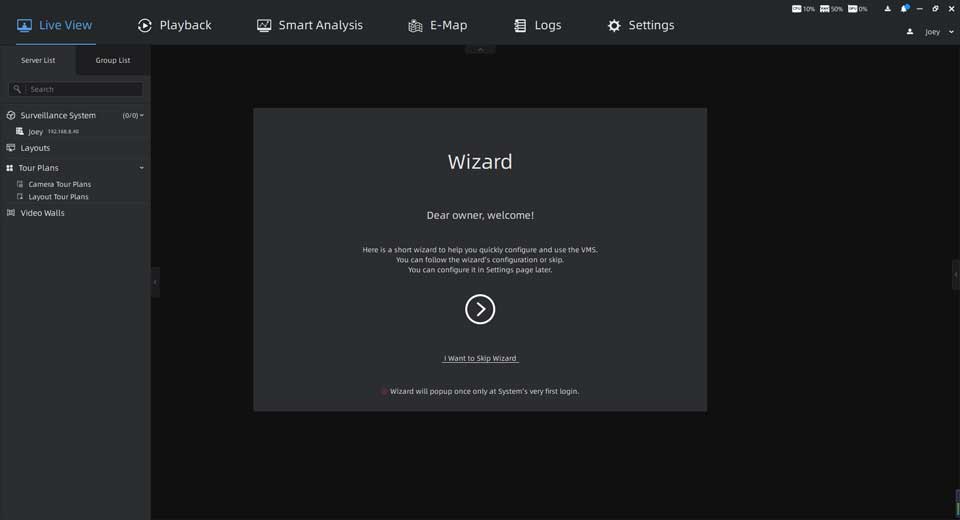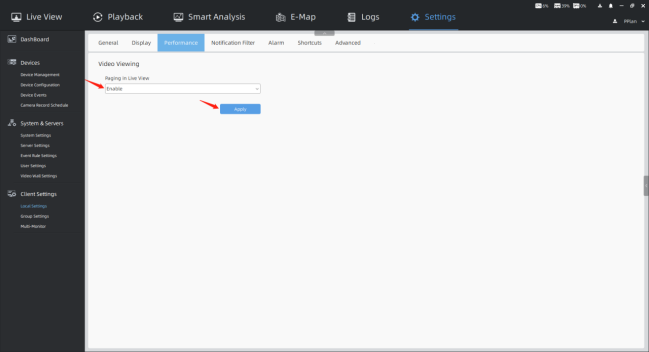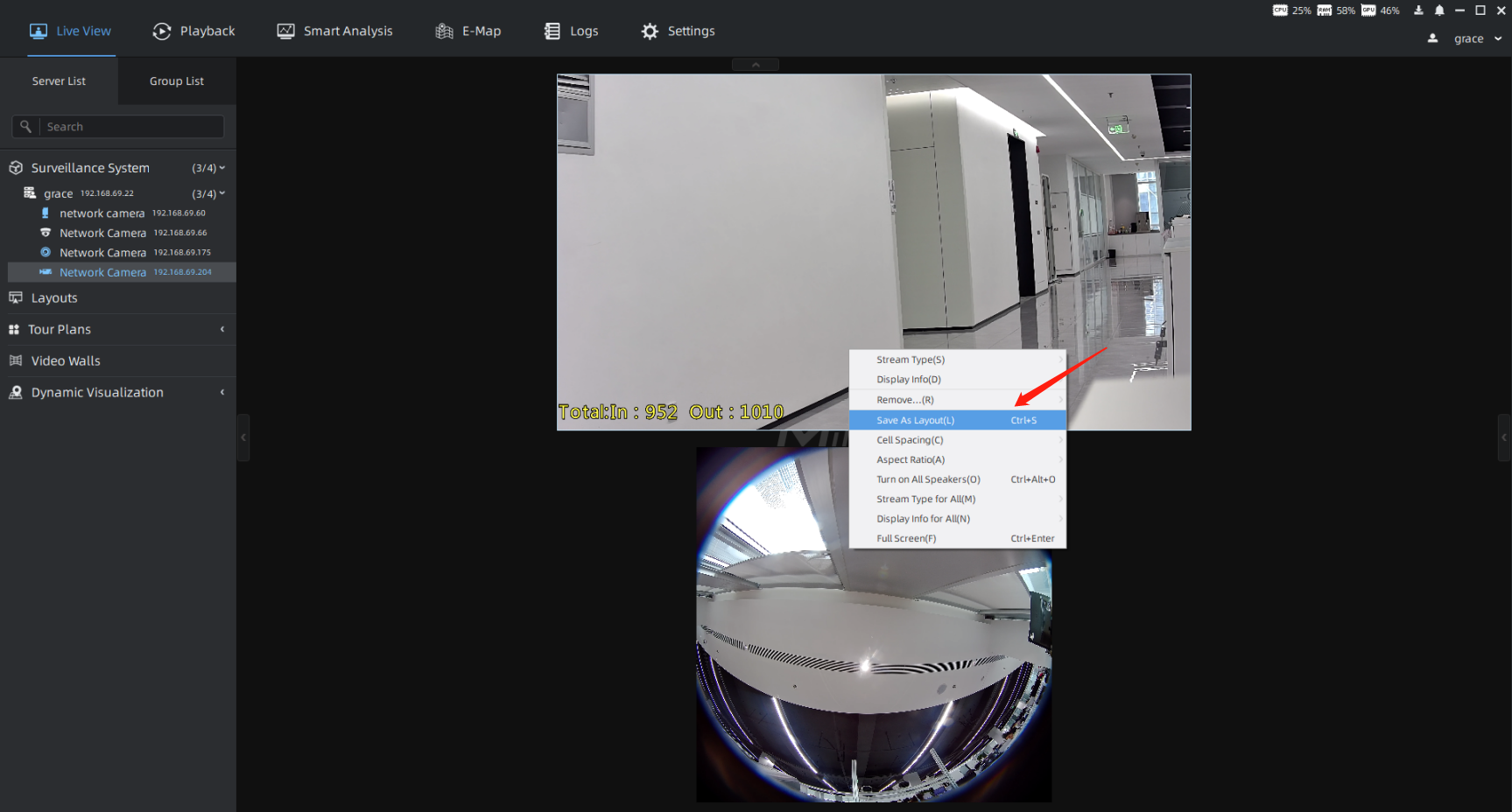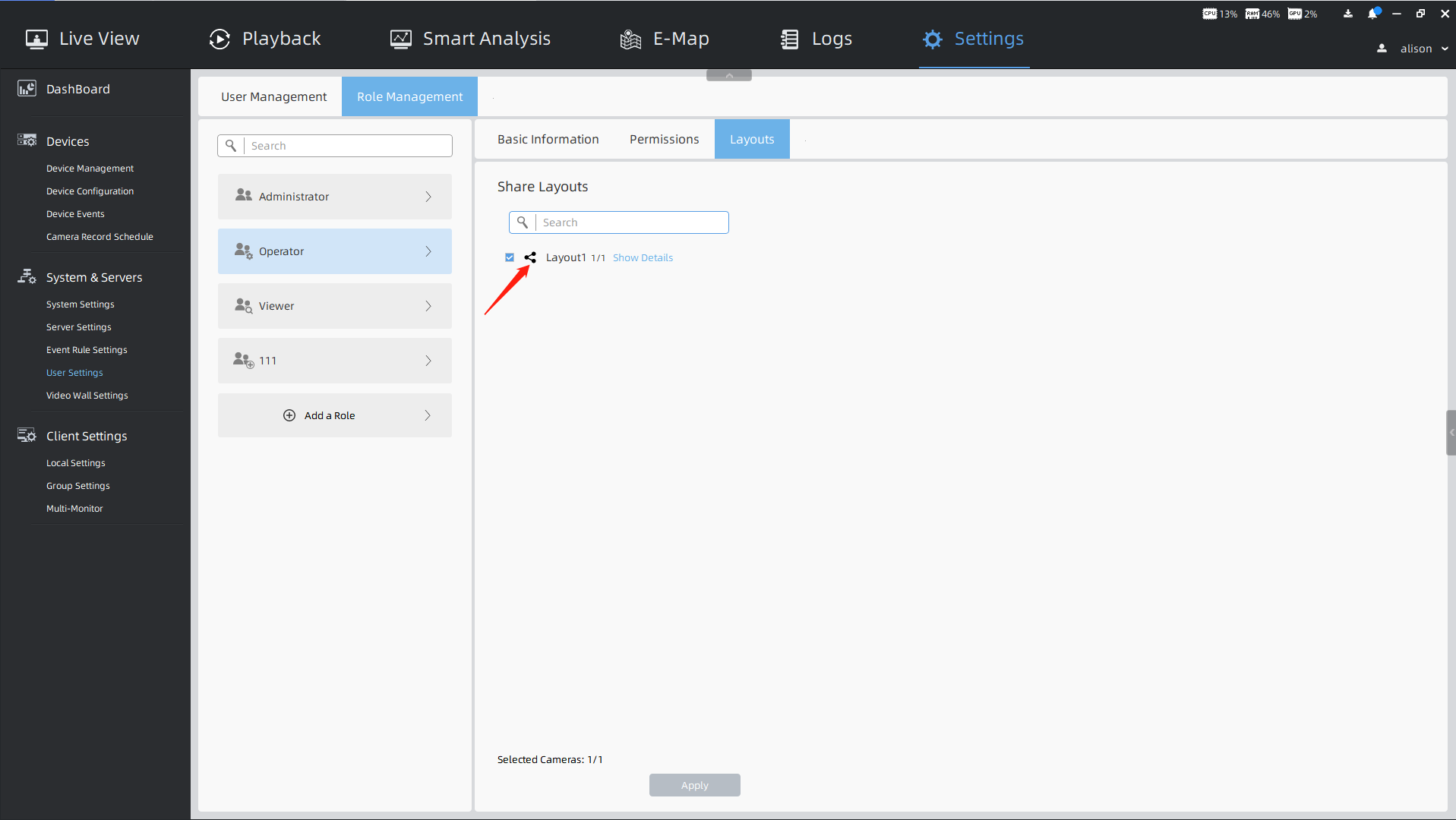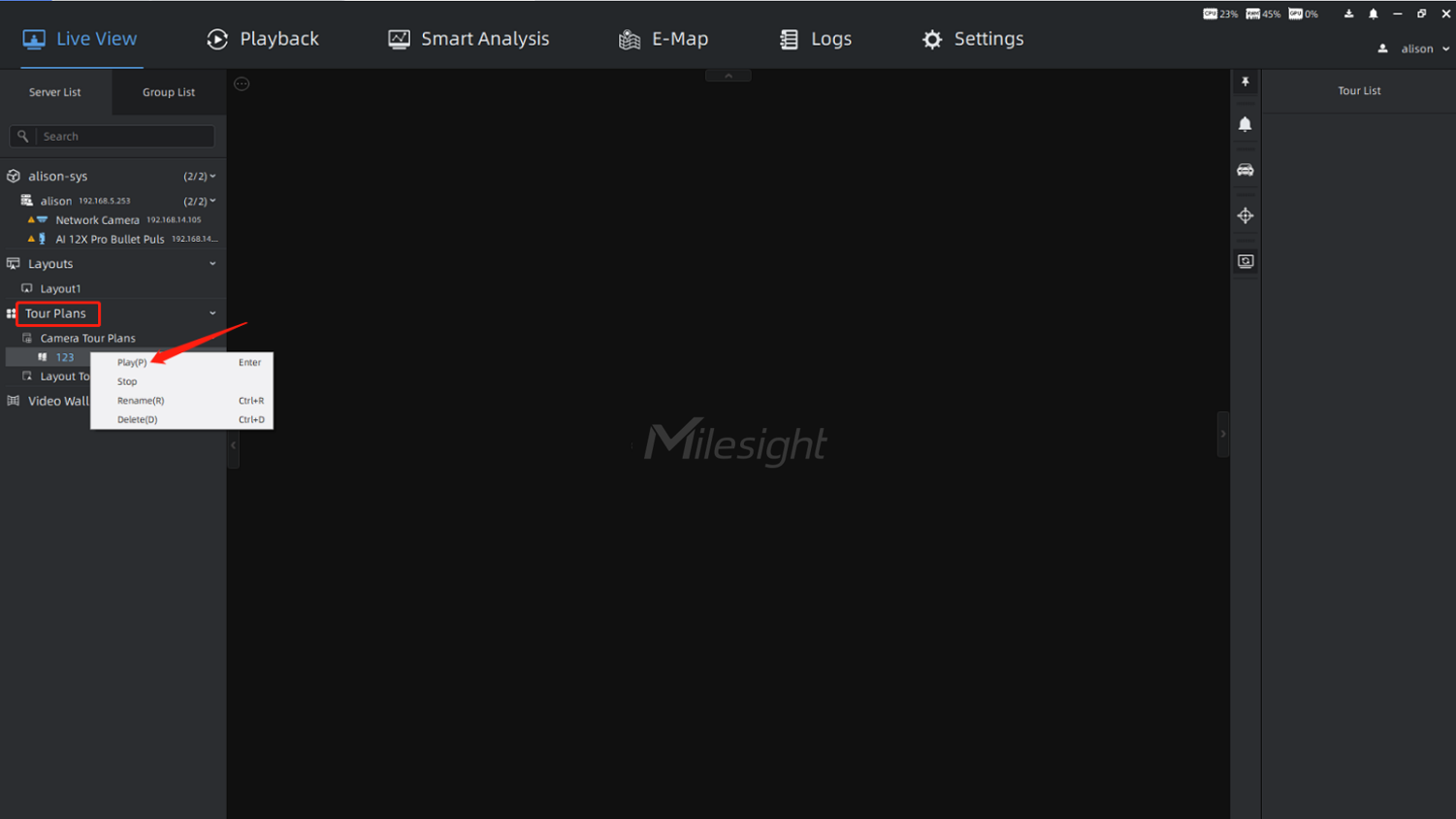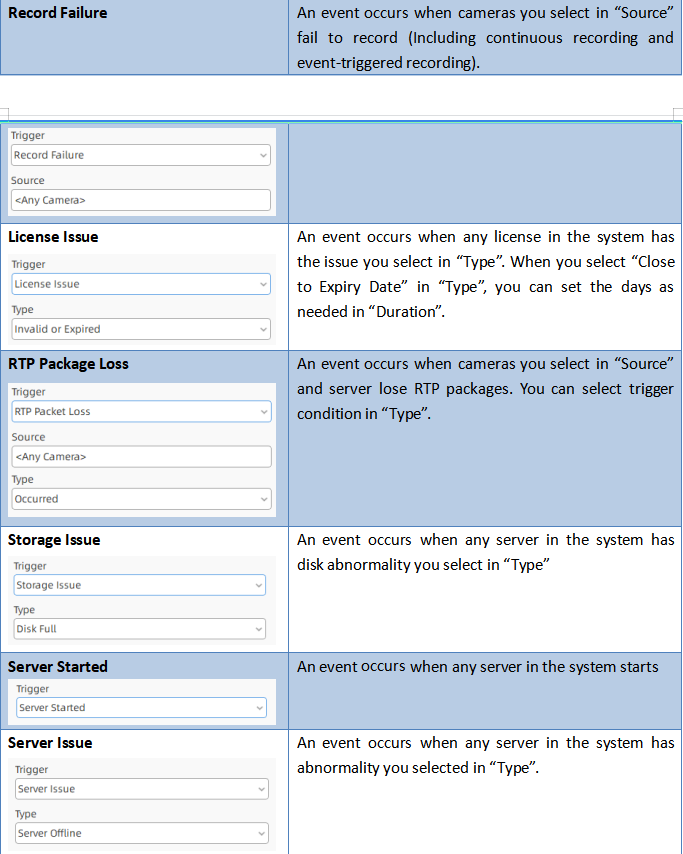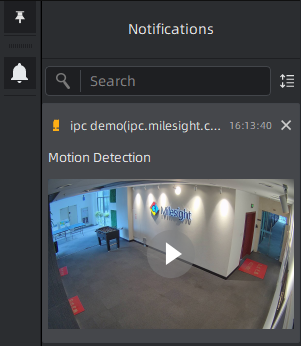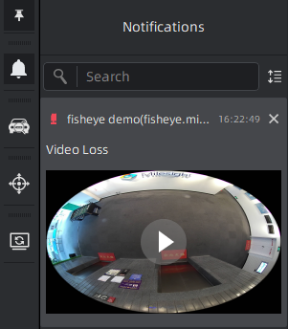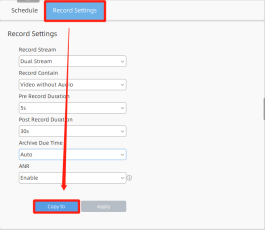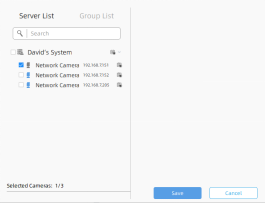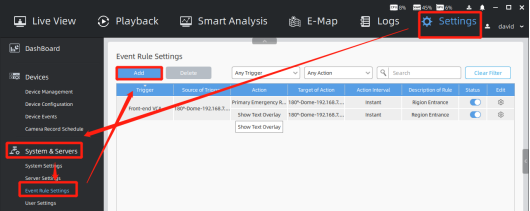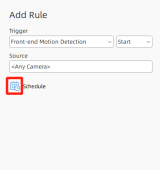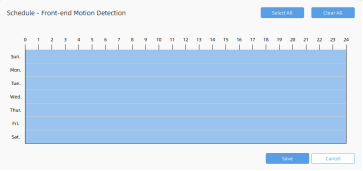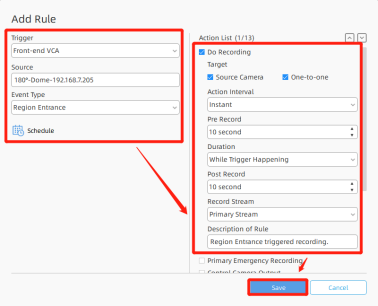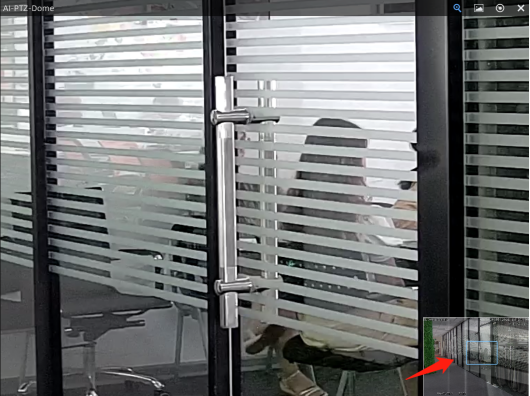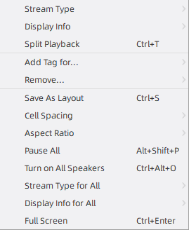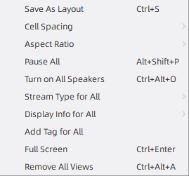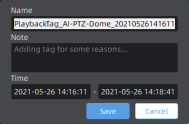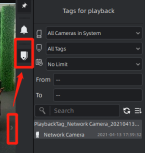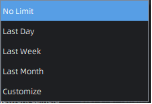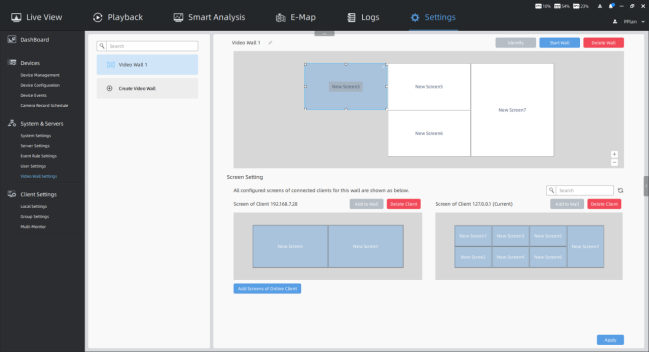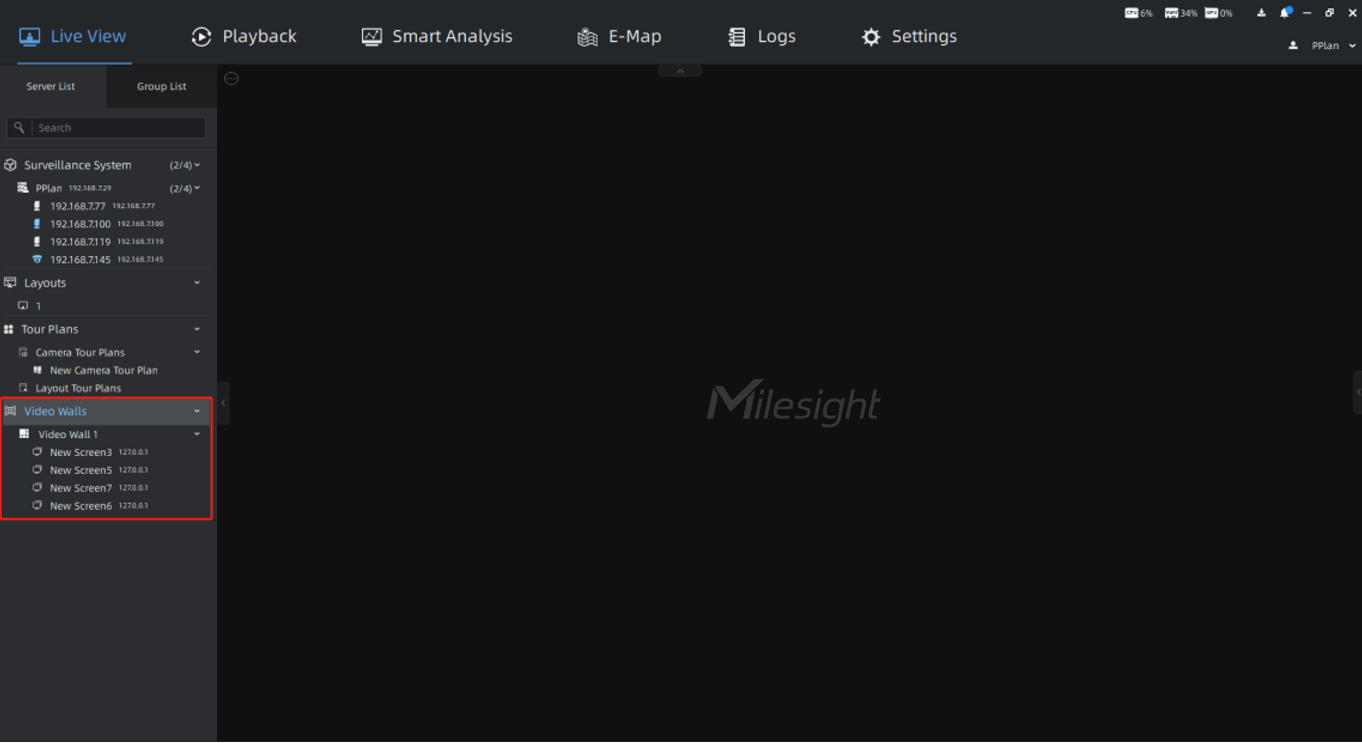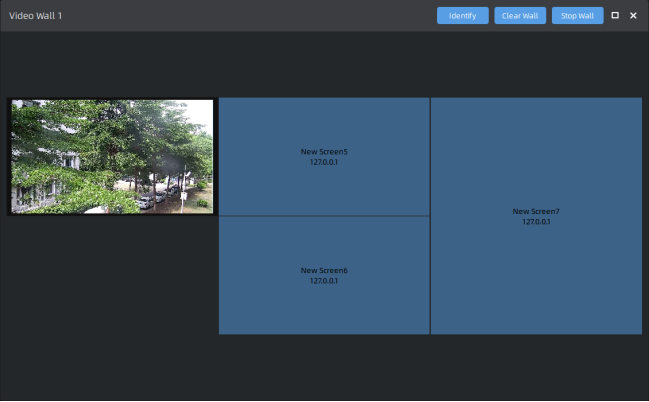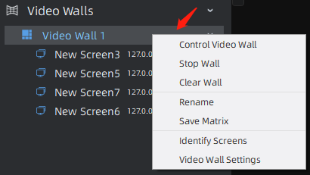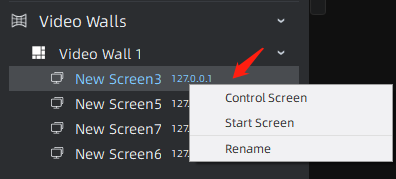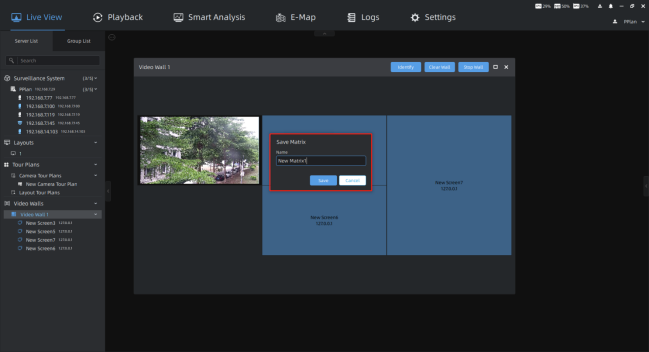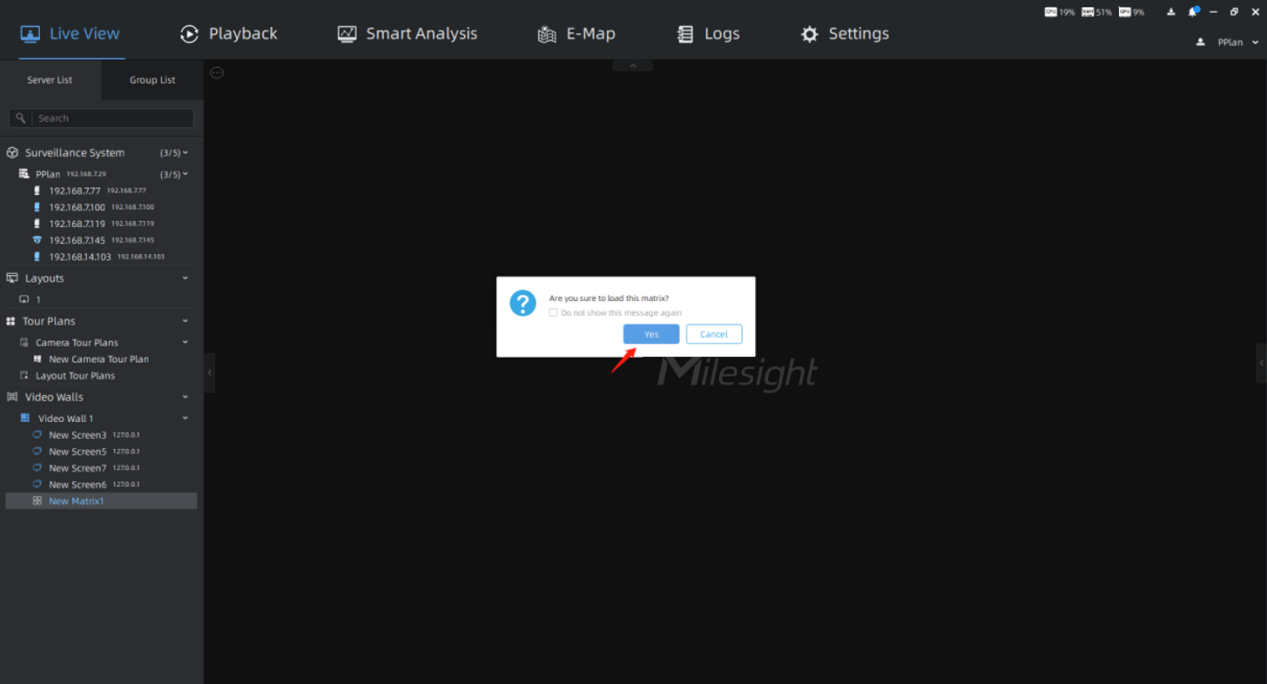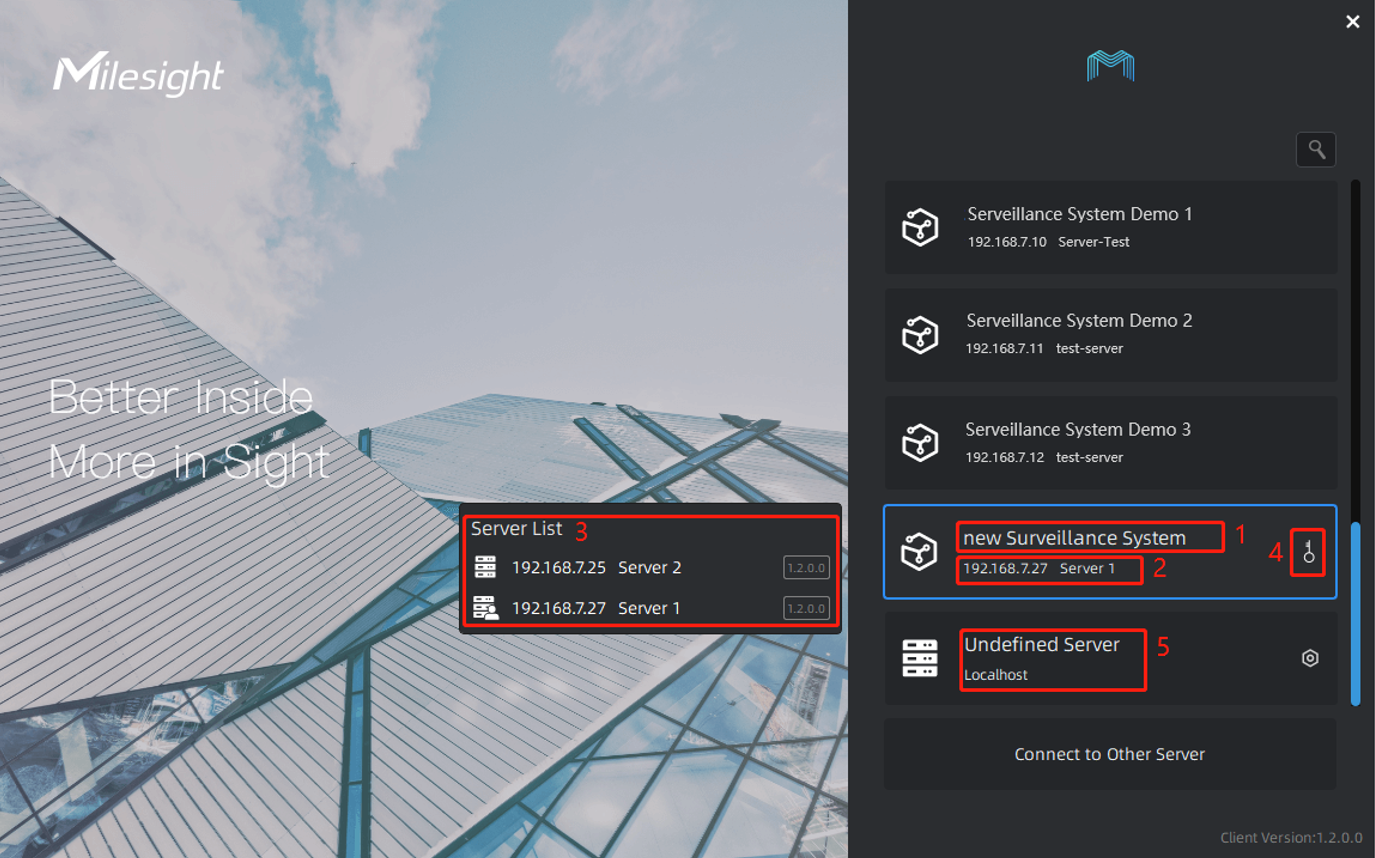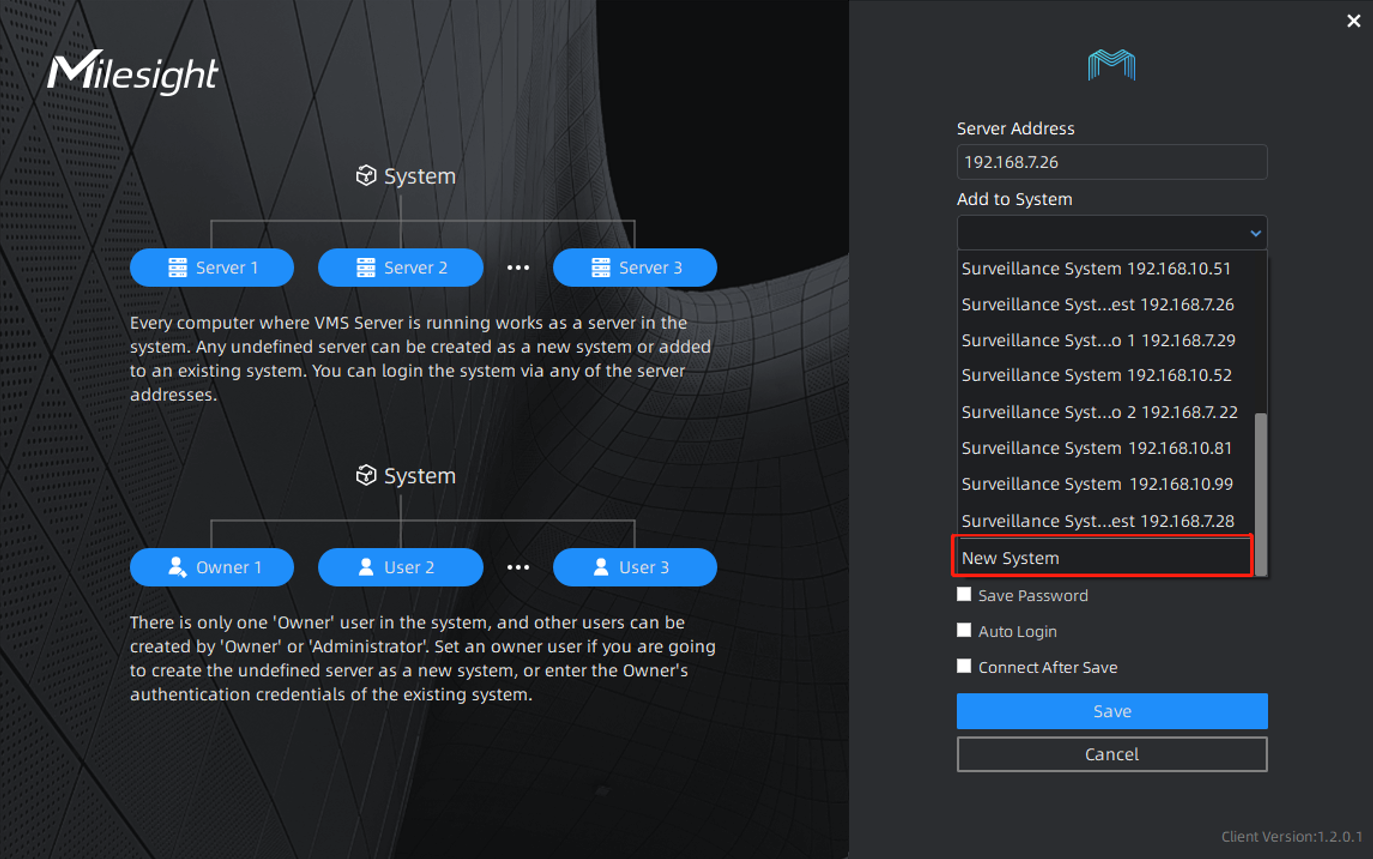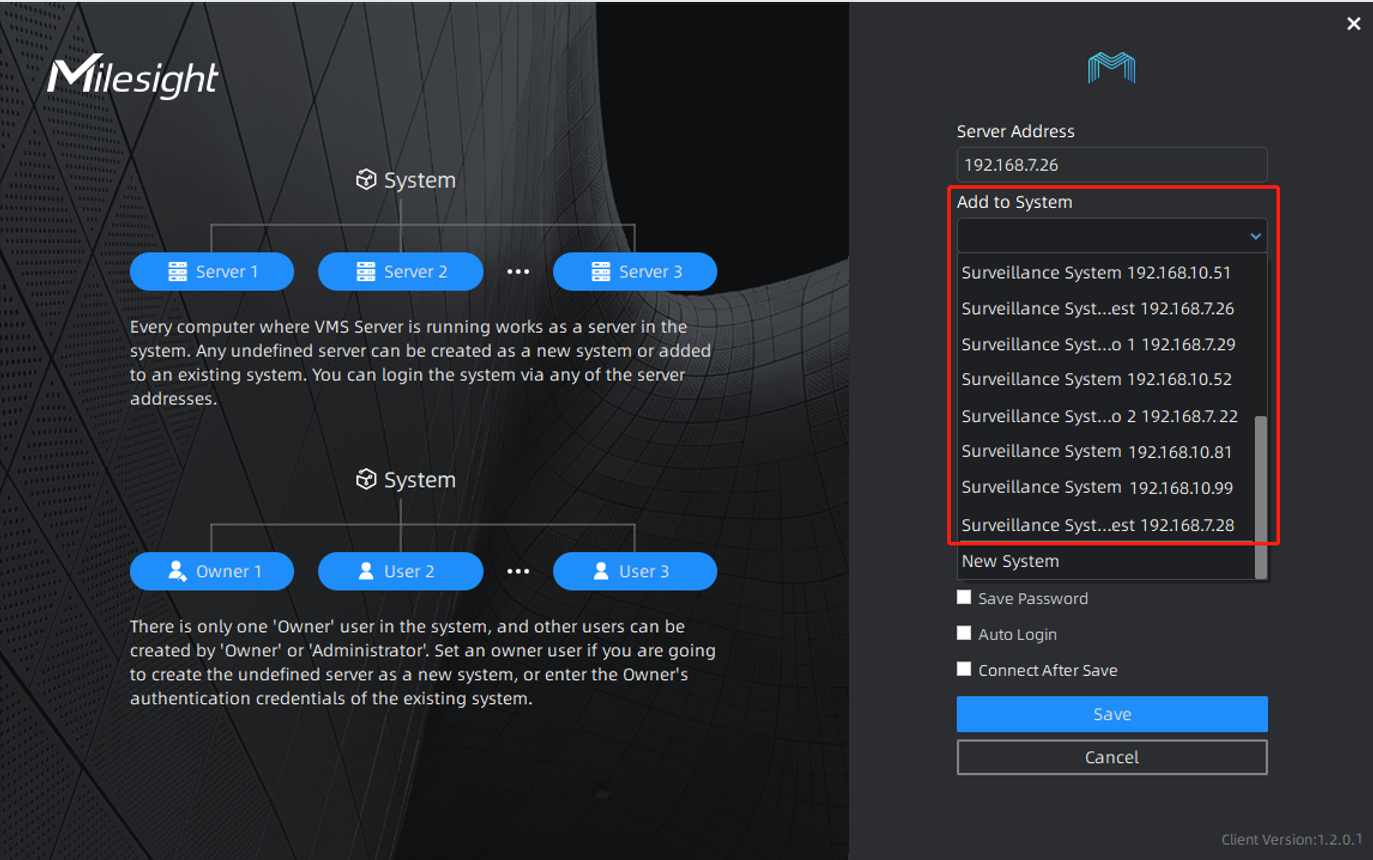Milesight VMS Enterprise Setup Guide, Milesight VMS Enterprise is a professional video management software. For using full functions, users need to get license and activate it. About the operation process, please check the details below.
How to activate VMS Enterprise
Milesight VMS Enterprise is a professional video management software. For using full functions, users need to get license and activate it. About the operation process, please check the details below.
1. Activate VMS Enterprise
1.1 How to activate in the Wizard interface
After logging into the system, the VMS system client interface will show as below. If you create Owner user and first login into the VMS system, there is a wizard window displayed in the client interface.The wizard will help you to quickly configure and use the VMS system, including some basic configuration page: Security, License, Devices and Storage. If you create a new system, then there is a pop-up wizard as shown below at system’s very first login and once only.
Here you can choose directly to skip wizard or click  button to star wizard, and in the second step of the wizard, we can activate the license.
button to star wizard, and in the second step of the wizard, we can activate the license.
Read More :
License
The License wizard will guide user how to activate license.
There are two options, including: “Enter License Key and I Want Free Trail”.
Note: Now Mliesight VMS only supports camera access license.
①: Free Trial Activation
Step1: Click  button. If this is the first time you use the VMS software, then a window will pop up as shown below:
button. If this is the first time you use the VMS software, then a window will pop up as shown below:

Step2: Select server which a license is registered to and click  button, then a Free Trail information card will show in the License wizard interface as shown below:
button, then a Free Trail information card will show in the License wizard interface as shown below:
Note: The Free Trial with 4 camera access is a time-limited experience license that expires
in 6 month after activation. You can contact our sales to purchase our license to access more channels.
②: Online Activation
Step1: Click  button and wait for several seconds, a window will pop up as shown below:
button and wait for several seconds, a window will pop up as shown below:

Step2: Select server and input activation code, then click the  button;
button;
Note: The format of the activation code is 16-digit hexadecimal, and the letters in it are all lowercase letters.
Step3: After you verify the activation code successfully, the license information card will show in the License wizard interface.
③: Offline Activation
Step1: Click  button. If neither target server nor client computer is not connected to the Internet, then licenses can be activated offline.
button. If neither target server nor client computer is not connected to the Internet, then licenses can be activated offline.
Step2: Select server and Input Activation Code, then click  button. Here you can operate according to current step tips.
button. Here you can operate according to current step tips.
1.2 How to activate in the Settings interface
Except activate license in the wizard, you also can activate license in the Settings interface, the steps are basically the same as in the “Wizard”. It could be found in the:
“Settings -> System&Servers -> System Settings -> License Activation”:
Click the  button, then the window will pop up as shown below, in this interface, you also can choose “Free Trial” , “Online Activation” or “Manual Activation”.
button, then the window will pop up as shown below, in this interface, you also can choose “Free Trial” , “Online Activation” or “Manual Activation”.
①: Free Trial
Step1: Click  button. If this is the first time you use the VMS software, then a window will pop up as shown below:
button. If this is the first time you use the VMS software, then a window will pop up as shown below:

Step2: Select server which a license is registered to and click  button, then a Free Trail information card will show in the License wizard interface and as shown below:
button, then a Free Trail information card will show in the License wizard interface and as shown below:

Note: The Free Trial with 4 camera access is a time-limited experience license that expires
in 6 month after activation.
After trying the free trial, you can choose to contact our sales to purchase the license to obtain the activation code, and add the license in the following steps to directly expand your layouts to 64 channels.
②: Online Activation
Step1: Select server and Input Activation Code, then click the  button;
button;
Step2: After you verify the activation code successfully, the license information will show in the interface, and you can continue to add more license by clicking  button.
button.

③: Manual Activation
Step1: Click  button. If neither target server nor client computer is not connected to the Internet, then licenses can be activated offline.
button. If neither target server nor client computer is not connected to the Internet, then licenses can be activated offline.
Step2: Here you can operate according to “current step” tips as shown below:




1) Click  button to export the “LicenseRequest.bin” file and save to your local storage path or flash memory, then click
button to export the “LicenseRequest.bin” file and save to your local storage path or flash memory, then click  button. The window will change as step tip2;
button. The window will change as step tip2;
2) Copy the address to another online server URL search box and the Milesight License Activation website will show as below. You can upload the previous exported “LicenseRequest_xxxx-xxxx-xxxx-xxxx.bin” here;
3) If the activation code is correct and valid, then the website will show as below. You can click  button to download the response file;
button to download the response file;
4) Import the downloaded license response file from activation website, and click  button to activate the license. If you want to import the response file later, you can click
button to activate the license. If you want to import the response file later, you can click  button.
button.

Finally the license has been activated successfully.
Note:
①: How to deactivate in the Settings interface
You can also choose to deactivate your license in the Settings interface and activate it on another computer. For example, when replacing a server: if you want to use this license on another computer, you could deactivate it from this server, and then activate it on another server.

After the operation is successful, a prompt interface will pop up, you can choose to “Reactivate” on this computer, or click “OK” to deactivate the license from your computer.
②: Multiple Activations
If you want more channels, you can contact the sales to buy the license again, and then activate it directly, the total number of channels will be superimposed on the previous number.
2. Status
After you activate the license successfully, the license will be added to the License Activation list and the working status will be displayed.
There are some other operations as below:
①: Click  button to import the response file to activate the license.
button to import the response file to activate the license.
②: Click  button to deactivate the license. After deactivation, this activation code can be reactivated or activated and used on other servers. The free trial license does not have this option.
button to deactivate the license. After deactivation, this activation code can be reactivated or activated and used on other servers. The free trial license does not have this option.
③: Click  button to delete the license. This option is only for the license whose status is not Working.
button to delete the license. This option is only for the license whose status is not Working.
④: Click  button to check each license details.
button to check each license details.
⑤: Click  button to export the license list in the system.
button to export the license list in the system.
⑥: Click  button to overview usage condition of activated licenses.
button to overview usage condition of activated licenses.
Note: Each License can only be registered to one server because license is bound with hardware information (Including: CPU serial number, motherboard serial number, BIOS serial number and the MAC address of the first physical network card) of computer on which server resides. If there is an exceptional occurrence of server, all licenses of the computer on which server resides will become invalid. And once the server starts to run, the licenses will automatically become valid and restore working status.
How to Set VMS Enterprise User
Chapter I Introduction
Milesight VMS Enterprise supports User Management and Role Management, which can be used to manage the user’s permission. User management and role management enable authorized users to use authorized functions normally and legally, but exclude unauthorized users, which greatly protects account security.
l User Management
Users can be added, modified and deleted from the User Management page in “Milesight VMS Enterprise Client”. Several properties of a user including User Name, Password, Confirm password, Role, Email Address and Remark can be configured.
l Role Management
Role Management supports configuring the same functions and operation permissions for multiple users under a role. The resource access of role includes Function, Operation, Camera and Layout. There are four types of role which can’t be deleted by default, including Owner, Administrator, Operator and Viewer. Also, you can add or delete customized roles. Different roles have different resource access:
Owner: There can only be one user who is Owner, which is the user added when the system is created, and the priority of role is highest.
Administrator: Own full access to function and operation permissions, resource access including Camera and Layout.
Operator: Own part access to function and operation permissions, resource access including Camera and Layout.
Viewer: Own part access to function and operation permissions, resource access including Camera and Layout.
Customized roles: You can customize the role permissions.
You can configure cameras for the customized roles. The administrator and owner can share their configured layout with the users under the role, so that users under the customized role can access to the devices in the layouts.
l The application of User&Role
User&Role can be used in E-map and Event Rule Settings. You can configure the user’s permissions on the E-map. And you can configure show notification to the specified users.
Chapter II User Settings
2.1 User Management
1. How to add a user
Step1: Click the button in the Settings -> System & Servers -> User Settings -> User Management interface.
Step2: Set the User Name, Password, Confirm password, Email Address and Remark as you want. And select a Role for the user, which include Owner, Administrator, Operator, Viewer and other custom roles.
Note:
1. There can only be one user who is Owner, which is the user added when the system is created, and the priority of role is highest.
2. The password must contain at least 8 characters and cannot consist of only digits or letters.
Step3: Configure user expiry date. When the user date expired, the user can’t login into the VMS system.
Note:
The user whose role is Owner never expire by default.
Step4: Configure three security questions for users, and each user can modify only his or her own security questions. Users need to answer these security questions before resetting the password, which greatly improves security.
Step5: Configure to change the password periodically, which are supported for better security protection. Change the password every 10 days, 30 days, 60days, 90 days or customize days are optional, and the system will prompt you to change the password periodically.
Step6: Configure to change password when first login. The system will automatically prompts you to set a new password at first login. This option is supported for better security protection, too.
Step7: Click the button to save the basic information for user. And the user will be created to the user list.
Step8: Click the icon toggle to enable or disable this user.
Note:
1. The created users are enabled by default. When logging in to the VMS Client system, the user cannot disable itself.
2. If user is disabled, then the VMS Client system which the user login to will logout compulsively and pop up a reminder window “User has been disabled or deleted, please contact administrator”.
1. How to modify a user
Step1: Click a user which you want to modify.
Step2: Modify the information you want to change.
Note:
1. The Role attribute of user whose role is Owner cannot be modified.
2. The user name must be unique.
Step3: Click the button to save the modified information. And a successful configured message will pop up in the lower right corner.
Note:
When you click other buttons outside the control panel before save the modified information, a window will pop up to inform you “Configuration is not saved, discard changes?”.
2. How to delete a user
Step1: Click a user which you want to delete.
Step2: Click the button , and a reminder window “This user will be deleted” will pop up. Click the button to delete the user.
Note:
If you check the checkbox to keep user history data and even if click “OK” button to delete the user, then tag or locked recording video files added by user can still be kept.
2.2 Role Management
1. How to manage roles
There are four types of role which can’t be deleted by default, including Owner, Administrator, Operator and Viewer. Also, you can add or delete customized roles. You can create multiple users under a role, then all users under the role will be listed in the User List.
Note:
You can click the button to delete the user under the role.
(1) How to add customized role
Step1: Click the button in the Settings -> System & Servers -> User Settings -> Role Management interface.
Step2: Set the Role Name and Remark you want.
Step3: Click the button to save the Basic Information for role. And the role will be created to the role list.
Note:
The role name must be unique.
(2) How to modify a role
Step1: Click a role which you want to modify.
Step2: Modify the information you want to change.
Step3: Click the button to save the modified information. And a successful configured message will pop up in the lower right corner.
(3) How to delete a role
Step1: Click a user which you want to delete.
Step2: Click the button and a reminder window “This role will be deleted” will pop up. Click the button to delete the user.
2. How to configure role’s permissions
Different roles have different functions and operation permissions, resource access including Camera and Layout.
(1) Administrator
Own full access to function and operation permissions, resource access including Camera and Layout. Even if Camera and Layout pages are not displayed, Administrator has full access to camera and layout of VMS system by default.
(2) Operator
Own part access to function and operation permissions, resource access including Camera and Layout. Even if Camera page is not displayed, Operator has full access to camera of VMS system by default.
Note:
1. The Operator has more access than the Viewer, like the Operator can operate the devices and access the Video Wall and Event logs.
2. The Layouts will be introduced in next part. About Layouts
(3) Viewer
Own part access to function and operation permissions, resource access including Camera and Layout. Even if Camera page is not displayed, Viewer has full access to camera of VMS system by default.
(4) Customized role
You can customize the role permissions.
Step1: Click a customized role which you want to configure the role’s permissions. And click the button.
Step2: Select permissions for customized role as needed.
Step3: Click the button to save the permissions. And then a successful configured message will pop-up in the lower right corner.
3. How to configure cameras for the customized roles
You can configure cameras for the customized roles as needed.
Step1: Select cameras for customized role as needed.
Step2: Click the button to save the cameras.
Note:
When the customized role has Device Management Permission, the camera cannot be disabled.
4. About Layouts
Here the users of Administrator or Owner role can select the Operator, the Viewer and the customized role to share the layout, so that users under the Operator, the Viewer and the customized role can use the layouts and have access to the devices in the layouts.
(1) How to configure customized layouts
Step 1: First, determine the channels and their locations you’re interested in, then right-click the camera live view window in the Live View interface to pop up a menu. And select option to save the layout.
Step 2: You can name the new layout, and clickbutton to save it. Then the layout will be displayed under the Layouts module in the left Resource Panel.
Step 3: Right-click the corresponding layout and selectoption to preview the camera in the layout. You can also directly double-click the corresponding layout for quick viewing.
Note:
The operation of setting layout in the Playback interface is the same as that in the Live View interface.
(2) How to share layouts
Step 1: In the Settings -> System & Servers -> User Settings -> Role Management interface, users of Administrator or Owner role can select the corresponding role to share the layout.
Step 2: Choose the layout you want to share on the Layouts page, and click button, the layout icon will change to . In this way, all users under the corresponding role can use this layout and have access to the cameras in the layout.
Step 3: Click button to check cameras in the layout. Hover your mouse over the channel to see the thumbnail and related information.
2.3 The application of User&Role
1. How to use User&Role in E-map
Step1: Click the button in the E-map -> User Permission interface.
Step2: Configure the user’s permissions of this Map. Manage and View Only are optional.
Note:
The user under the customized role can see the assigned resources only.
Step3: Click the button to save configuration.
2. How to use in Event Rule Settings
Step1: Click the button in the Settings -> System & Servers -> Event Rule Settings interface.
Step2: Configure to show notification to the specified users.
Step3: Click the button to save configuration.
How to set up Failover on VMS Enterprise
1. Introduction
In order to improve users data protection and data security, we have added the Failover function in VMS Enterprise. In the same system, when a server fails, other servers with Failover function enabled will take over the camera and keep recording the video of failed server.
Note:
1. To use this function, need at least two servers.
2. When the failed server is restored, the camera’s video during the failure will remain on the replaced server and will not be sent back to the original server.
3. When multiple servers are ready for taking over the camera, the system dynamically allocates the camera based on the load of each server.
2. How to Set Failover
2.1 Add multiple servers to the same system
If the server is not added to any system, it is an Undefined server. You can select and add them to any system.
Note:
1. If the current server has been added to another system, the server can be detached from the system. Please follow the steps below to set it up.
2. To add into a system, need to enter the account and password of the system owner.
Step 1: Login to the VMS Enterprise, Select“Settings”-> Click“Server Settings”-> Choose a “server”-> Click“Detach Server”
Step 2: Choose“Remove or Keep cameras of this server from system” —> Wait for 5 seconds and click  button to detach the selected server from this VMS system, then the server will become an undefined server.
button to detach the selected server from this VMS system, then the server will become an undefined server.
(1) Only the Owner user has permission to perform the Detach Server operation and check the detach result.
(2) When there is an exceptional occurrence of server to make it offline, if you directly click  button, the deleted server is not actually detached from system. Once server restores normal status, the server still can display in the interface and start working.
button, the deleted server is not actually detached from system. Once server restores normal status, the server still can display in the interface and start working.
(3) After the last server is detached, all clients connected to the system will be forced to logout, and pop up a window to inform you“All servers in this system have been removed, please set up system or contact administrator”.
2.2 Set Failover
Step 1: Connect to the system, Select“Settings”-> Click“Server Settings”-> Choose a server -> Click“Failover”
Note: The“Max cameras allowed on this server”is depend on the VMS activation code.
(1) Check  to enable the Failover function.
to enable the Failover function.
(2) Check and all cameras in the system and their priorities will be displayed on the list below.
and all cameras in the system and their priorities will be displayed on the list below. indicates that continuous recording is enabled.
indicates that continuous recording is enabled. indicates that continuous recording is disabled.
indicates that continuous recording is disabled.
(3) You can select the cameras and set the priority including High, Medium, Low and Never. Then click  button.
button.
(4) Finish the setting and click  button.
button.
Note:
There must be unoccupied channels on the server whose Failover function is enabled. Only when the number of channels on the server is less than 128, the server whose Failover function is enabled can take over the channels of other servers.
VMS Enterprise ANPR Solution
I. What is ANPR
ANPR(Automatic Number Plate Recognition) is a technology that uses optical character recognition on images to read vehicle registration plates. For Milesight, the ANPR algorithm is embedded in cameras, which allows the cameras to recognize, capture and upload license plate images all alone and intelligently.

II. Why Milesight ANPR Solution
Ø Quick Capture & Accurate Recognition
l Accurate License Plate Identification Under all kinds of conditions

l High-reliability License Plate Recognition with more than 95% high performance accuracy
1. Up to 4 Detection Regions
2. Reliable Confidence Level
3. Vehicle Direction Recognition
4. Detection Regions of PTZ
5. DACH Region Recognition
Ø Intelligent Analysis & Efficient Management
- White and Black List Management
- A Stand-alone ANPR Solution
- Fully Integrated with Milesight NVR/CMS/VMS Enterprise
- 3rd Integration: CGI
Ø Adaptable to Most Operation Requirements
- Max recognition speed 120 km/h
- Over 70 countries and regions
- Various options
LPR 12X H.265+ AF Motorized Pro Bullet Network Camera
LPR 12X H.265+ Mini PTZ Bullet Network Camera
LPR H.265+ ABF Pro Box Network Camera
LPR H.265+ Mini Bullet Network Camera
LPR H.265+ Vandal-proof Motorized Mini Bullet Network Camera
LPR H.265+ Motorized Pro Bullet Network Camera
III. Countries/Regions that support ANPR
Currently, we have three kinds of LPR, including LPR1, LPR2 and LPR3. LPR1 is used in Asian region, LPR2 is for European region, and LPR3 is for Korea. It covers over 70 countries and regions.
LPR1:
LPR2:
CIS (former Soviet Union)
IV. How to set ANPR with Milesight Network Cameras
1. Settings
Step1: Go to“LPR”->“Settings”,after log in the web.
Check the checkbox “Enable License Plate Recognition”, and you can draw the screen to select the areas interested. There will be shown in the blue box as below.

[License]: A license will be automatically assigned to each device.
[License Status]: This column is used to display the status of the license, “Valid”or “Invalid”.
[Processing Resolution]: Default resolution selected is 1280*720. You can choose different resolution according to the network environment.


[Set LPR Detection Region]: You can set up to 4 ROI areas by drawing the screen. If you choose Normal Mode, it supports configuring the LPR detection regions for the current area. If you choose Advanced Mode
(Only for PTZ series), it supports configuring different LPR detection regions for different PTZ presets(Only support Preset 1~4 so far).

[LPR Night Mode]:
Achieve the best effect of LPR night recognition by adjusting different parameter levels. You can also schedule the Start Time and End Time, and adjusting the level according to the environment.
Step2: Schedule Settings. You can draw the schedule by clicking“Edit”button. And then click “Save” or “Reset” after finishing the setting.


Step3: Detection Settings and LPR Message Post Settings.

[Detection Trigger]: If you choose “Always”, camera will always detect the license plate. If you choose “Alarm input”, camera will only detect the license plates when Alarm Input is being triggered.
[Confidence Level]: You can set the confidence level from 1 to 10. When the confidence level of the license plate is higher than the set confidence level, it will push the license plate image to the logs interface.
[Repeat Plate Checktime]: Set the time interval for repeatedly reading license plates to effectively avoid duplicate identification of parking vehicles.

[License Plate Serial Format]: Formulate identification rules and automatically filter wrong license plate information to achieve more intelligent and accurate license plate recognition.
[Feature Identification]: Check Region, Direction, ROI_ID or All to enable Features Identification, it will display the corresponding information on the logs interface.
Note: Region detection only supports DACH region.
[LPR Message Post Settings]: Check the checkbox to enable LPR Message Post. It will push information to some third-party devices or software that are compatible with ours. Information can be pushed by RTSP, TCP or HTTP.
More information about LPR Message Post, please refer to Milesight-Troubleshooting-Integration between LPR Camera and NVR(VMS).
Step4: Don’t forget to click “Save” after finishing all settings.
2. List Management
Add the license plates to this interface as Black or White type (Black/White List), and then you can set the alarm action for these license plates in the corresponding Black list mode or White list mode interface. When these license plates are detected, the camera will respond to your settings accordingly.

[Add License Plate]: Select the license plate type as black or white, enter the license plate number, click the “Add” button, the license plate number will be added successfully.
[Batch Upload]: You can add a csv file of the license plates you want to add, click the “Browse”button to import the form to this interface, click the“Upload”button, the license plates will be added successfully.
[List Search]: Select Plate Type or directly enter the license plate number, click the “Search”button, the corresponding license plate will be displayed in the list as below.
[Export List]: Click the“Export List”button to export the license plates in the current list as a csv file locally.
[Delete List]: Click the“Delete List”button to delete all the license plates
in the current list.
3. Black /White/Visitor List Mode
Step1: Check the checkbox to enable Black List Mode.
Step2: Schedule Settings. You can draw the schedule by clicking“Edit”button.
Step3: Set Alarm Action.

Table 1 Description of the buttons
Step4: Set Alarm Settings.

Table 2 Description of the buttons
After that, when a license plate marked as“Black”,“White”,“Visitor”is detected, the camera will respond accordingly to your settings.
4. Professional LPR Liveview Interface
Milesight LPR camera supports professional LPR Live View interface. You can see the real-time license plate recognition results.

Note:
① Upgrade your device to corresponded firmware version.
Camera: V4X.7.0.74 or above.
Firmware download link: http://www.milesight.com/support/download#firmware
② If there is no SD card or NAS as the storage space, the snapshots of license plate will be temporarily stored locally on the PC, cleared after logging out, and do not support Smart Search which will be introduced in the next part.
5. Smart Search

Step1: Select Plate Type or directly enter the license plate number.
Step2: Select Start Time and End Time, click the “Search” button to achieve fuzzy search, then the corresponding license plates or license plates containing search keywords will be shown on the logs while the complete video and license plate information will be shown on the left of the interface.

There are two methods to backup LPR logs.
① Backup license plates you want.
Step1: Tick license plates you want to backup and click “Backup” button ;
Step2: Select the export file type, video stream type and video file format, then click “Export” button.

② Backup all.
Step1: Click “Export All” button;
Step2: Select the export file type, video stream type and video file format, then click “Export” button.
You can also click the “Auto Export” button to automatically export the logs to FTP, SMTP or Storage.

Note:
① Insert available SD card or add NAS to camera as storage. Otherwise, you can’t check the LPR recording and snapshots.
② Upgrade your device to corresponded firmware version.
Camera: V4X.7.0.74 or above.
Firmware download link: http://www.milesight.com/support/download#firmware
V. How to set ANPR with Milesight NVRs
1. Preparation
Here are some notes you should notice before using ANPR function.
① Insert available HDD or add NAS to NVR as storage. (Otherwise, you can’t check the recording and logs.)
② Upgrade your device to corresponded firmware version.
Camera: V4X.7.0.72-r16 or above.
NVR: V7X.9.0.7-r7 or above.
Firmware download link: http://www.milesight.com/support/download#firmware
③ Ensure your device support LPR/ANPR function.
Model of NVR:
-
MS-N7016-UH / MS-N7032-UH(16 ANPR Channels)
-
MS-N8032-UH / MS-N8064-UH(16 ANPR Channels)
-
MS-N7016-UPH / MS-N7032-UPH(16 ANPR Channels)
Name of LPR Camera:
④ Ensure that NVR can get license plate information. Please set TCP as Post Type which is the default mode. It can be set in Camera web page -> Advanced Settings -> ANPR -> Settings interface.

2. Settings
Step1: Go to“Event”->“ANPR”, select a channel and enable ANPR function.

[License]: A license will be automatically assigned to each device.
[License Status]: This column is used to display the status of the license, “Valid”or “Invalid”.

[Processing Resolution]: Default selected resolution is 1280*720. Users can choose different resolution according to the network environment.
Step2: Set ANPR function effective time. You can draw the schedule by clicking“Edit”button. Draw the schedule and then click “OK” or “Apply” after finishing setting.

Step3: Set detection parameters including Detection Trigger, Repeat Plate Checktime and Features identification.
[Detection Trigger]: Always and Alarm Input are available. It will only detect when alarm input is triggered if you select Alarm Input.
[Confidence Level]: You can set the confidence level from 1 to 10. When the confidence level of the license plate is higher than the set confidence level, it will push the license plate image to the logs interface.
[Repeat Plate Checktime]: The same license plate information won’t be received on NVR within the time you set.
[Feature Identification]: Check Region, Direction, ROI_ID or All to enable Features Identification, it will display the corresponding information on the logs interface.
Note: Region detection only supports DACH region.

Step4:
Set the detected ROI region which can be up to 4 regions. License plate will only be detected in the ROI regions.

3. List Management
Make a license plate list for your own NVR ANPR system.
Upload license plates and set them with different license type here. 10000 License plates can be added at most.
Kindly note that the list is exclusive for NVR, working with all LPR cameras you add. It won’t synchronize with the list on camera side.

There are two methods to add license plates:
① Add one by one.
Step1: Click Add button  .
.
Step2: Input the license plate and select license type.
Step3: Click OK and then the license plate will be added into the list.

② Batch upload by importing template.
Step1: Click Download Template button  , select USB device folder and click OK to download Template.
, select USB device folder and click OK to download Template.
Step2: Input all license type and license plate number as Template shows.

Step3: Click Import button  , select the file and click OK to add all license plates into list.
, select the file and click OK to add all license plates into list.

4. Black/White/Visitor List Mode
We provide you three modes for better event management.
Black List Mode: Manage event for license plates in black list.
White List Mode: Manage event for license plates in white list
Visitor Mode: Manage event for those license plates do not have license type.

Steps for settings:
Step1: Enable Black List Mode/White List Mode/Visitor Mode as your demand.
Step2: Set effective time for the mode to work.
Step3: Set actions you need including Audible Warning, Email Linkage, Event Popup, PTZ Action, Alarm Output and Trigger Channels Record.

Note:
Do not forget to enable these modes, set effective time and record action for corresponded mode, so that you can get real-time video when license plate is detected (Effective time and record action is enabled by default.). You can refer to How to check ANPR record part for detailed record settings.
5. Professional LPR Liveview Interface
At the beginning, you need to switch the preview mode to ANPR mode.
There are two methods to enter live view ANPR Mode:
① Right click the mouse and select ANPR Mode as preview mode.

② Select ANPR Mode on live view bottom tool bar.
After entering ANPR mode, the real-time license plate information will be shown on the left of the interface once it get detected.

License plate information includes Plate Snapshot, Channel Name, License Plate Number, Detected Time and Plate Type.
Two License types:
 —- License plate from Black List
—- License plate from Black List
 —- License plate form White List
—- License plate form White List

No License plates type will be shown if the license plate does not exist in Black/White list.
However, you can right click the license plate information to quick add it to Black/White list or delete it from Black/White list.

Besides, you can click the license plate information to check the latest X seconds (10s~20s) video.

Note:
1. X = 10 + Pre Record Time
You can set Pre Record Time in Storage -> Video Record -> Record Settings interface.

2. Make sure that HDD is available on NVR and correct record settings is made, so that you can check the record on live view. Please refer to How to check ANPR record part for detailed record settings.
3. Make sure that NVR can get the license plate information. Please set TCP as Post Type which is the default mode. It can be set in Camera web page -> Advanced Settings -> ANPR -> Settings interface.

6. Set/Check ANPR Record
Before checking recording files, please make sure that you have proceed correct settings to make record action work.
Step1: Set Smart Analysis as Record Type in Storage -> Video Record -> Record Schedule interface.

Step2: Enable Black List Mode / White List Mode / Visitor Mode as your demand.
Step3: Set Effective time and Trigger Channels Record action of your selected mode (Full effective time and trigger channel record are set by default).

Then NVR will record when license plate is detected .
Note:
Generally, record action is triggered by event. If you just enable ANPR function without enabling Black List/White List/Visitor modes nor setting record action, it means you just enable the function while record action is not set. Then no record will be triggered. So it is necessary to do all above three steps if you want to trigger record action.
Step1: Entering Playback -> Event Playback -> Smart Analysis interface.
Step2: Input corresponded information and click search button  to search.
to search.

Step3: Click record to play the video searched out .

Click the license plate information to check the latest X seconds (10s~20s) video.
Note:

7. Check/Backup ANPR Logs
Step1: Search on Smart Analysis interface.
Step2: Input corresponded information and click search button  to search.
to search.

Then you will get a whole ANPR logs list.
License plate snapshot will be shown on the logs list while the complete image video and license plate information will be shown on the left of the interface.

Step3: Click to play the video.

Two methods are available after searching ANPR logs out .
Step1: Tick license plates you want to backup and click backup button  .
.
Step2: Select the export file type, video stream type and video file format, then click export button.

Step1: Click backup all button.
Step2: Select the export file type, video stream type and video file format, then click export button.
Then you will get corresponded file as selected export file type.

VI. How to set ANPR with Milesight CMS
1. Preparation
① Refer to the NVR section
② Upgrade your CMS to corresponded version.
CMS: V2.4.0.7 or above
Download link: http://www.milesight.com/support/download#software
2. Settings
Step1: Add NVR to CMS.
Step2: Go to“Device Config”, select a NVR and the channel, then enable ANPR function.

[License]: A license will be automatically assigned to each device.
[License Status]: This column is used to display the status of the license, “Va
[Set LPR Detection Region]: You can set up to 4 ROI areas by drawing the screen. License plate will only be detected in the ROI regions.

[Processing Resolution]: Default selected resolution is 1280*720. Users can choose different resolution according to the network environment.
Step2: Set ANPR function effective time. You can draw the schedule by clicking“Edit”button. Draw the schedule and then click “OK” or “Apply” after finishing setting.

Step3: Set detection parameters including detection trigger, repeat plate checktime and features identification.
[Detection Trigger]: Always and Alarm Input are available. It will only detect when alarm input is triggered if you select Alarm Input.
[Confidence Level]: You can set the confidence level from 1 to 10. When the confidence level of the license plate is higher than the set confidence level, it will push the license plate image to the logs interface.
[Repeat Plate Checktime]: The same license plate information won’t be received on NVR within the time you set.
[Feature Identification]: Check Region, Direction, ROI_ID or All to enable Feature Identification, it will display the corresponding information on the logs interface.
Note: Region detection only supports DACH region.

3. List Management
Make a license plate list for your own NVR ANPR system.
Upload license plates and set them with different license type here. 10000 plates can be added at most.
Kindly note that the list is exclusive for NVR, working with all LPR cameras you added. It won’t synchronize with the list on camera side.

There are two methods to add license plates:
① Add one by one.
Step1: Click Add button .
Step2: Input the license plate and select license type.
Step3: Click OK and then the license plate will be added into the list.

② Batch adding by importing template.
Step1: Click Download Template, select folder and click OK to download Template.
Step2: Input all license type and license plate number as Template shows.

Step3: Click Import button , select the file and click OK to add all license plates into list.
4. Black/White/Visitor List Mode
We provide you three modes for better event management, which is based on two license types.
Black List Mode: Manage event for license plates in black list.
White List Mode: Manage event for license plates in white list
Visitor Mode: Manage event for those license plates do not have license type.
Steps for settings:
Step1: Enable Black List Mode/White List Mode/Visitor Mode as your demand.
Step2: Set effective time which means Mode works during that.
Step3: Set action including Audible Warning, Email Linkage, PTZ Action, Alarm Output.

5. Set ANPR Record
Step1: Set Smart Analysis as Record Type in Device -> Select NVR -> Record Schedule interface.

Step2: Enable Black List Mode / White List Mode / Visitor Mode as your demand.
Step3: Set Effective time and Trigger Channels Record action of your selected mode(Full effective time and trigger channel record are set by default).

Then NVR will record when license plate is detected .
Note:
Generally, record action is triggered by event. If you just enable ANPR function without enabling Black List/White List/Visitor modes nor setting record action, that means you just enable the function while record action is not set. Then no record will be triggered. So it is necessary to do all above three steps if you want to trigger record action.
6. Check/Backup ANPR Logs
① Check ANPR logs
Step1: Search on Smart Analysis interface.
Step2: Input corresponded information and click search button  to search.
to search.
Then you will get a whole ANPR logs list.
License plate snapshot will be shown on the logs list while the complete image video and license plate information will be shown on the left of the interface.

Step3: Click  to play the video.
to play the video.

② Backup ANPR logs
Two methods are available after searching ANPR logs out .
1. Backup license plates you want.
Step1: Tick license plates you want to backup and click backup button  .
.
Step2: Select the Export File Path, File Type, Video stream type and Video file format, then click export button.

2. Backup all.
Step1: Click backup all  button.
button.
Step2: Select the export file type, video stream type and video file format, then click export button.
Then you will get corresponded file as selected export file type.

VII.How to set ANPR with Milesight VMS Enterprise
1.Preparation
① Refer to the NVR section
② Upgrade your VMS Enterprise to corresponded version.
VMS Enterprise: V1.3.0.0 or above
③ Only the LPR cameras added by MSSP protocol support ANPR function for VMS Enterprise.
④ Make sure that VMS Enterprise can get the license plate information. Please set TCP as Post Type which is the default mode. It can be set in the Smart Analysis -> ANPR Settings -> Detection Settings interface.

2.Detection Setting
Here the configuration of the camera web side will be automatically obtained. If the camera web side is not configured, you can configure it in the interface of VMS. After the configuration is completed, it will be synchronized to the camera web side.

Step1: Select a camera in the devices list tree, then click  button to enable Detection.
button to enable Detection.

[License]: Only LPR2 and LPR3 need to enter the license to activate the LPR function.
[License Status]: Show present license status, including Valid and Invalid. When the license status changes to be valid, the camera can start detecting the license plates.
[Process Resolution]: Resolution of the stream for LPR analysis, including 1920*1280, 1280*720.
Step2: You can click  button to enable LPR Night Mode. The LPR Night Mode supports the optimal LPR night recognition effect by adjusting different parameter levels. You can choose Auto Mode which can automatically switch to night mode according to illumination intensity, or choose Customize Mode to set effective time manually.
button to enable LPR Night Mode. The LPR Night Mode supports the optimal LPR night recognition effect by adjusting different parameter levels. You can choose Auto Mode which can automatically switch to night mode according to illumination intensity, or choose Customize Mode to set effective time manually.


Auto Mode Customize Mode
Step3: You can set up to 4 ROI areas by drawing the screen. If you choose Normal Mode, it supports configuring the LPR detection regions for the current area. If you choose Advanced Mode(Only for PTZ series), it supports configuring different LPR detection regions for different PTZ presets(Only support Preset 1~4 so far).


Normal Mode Advanced Mode (For PTZ camera)
Step4: Schedule Settings. You can draw the schedule by clicking  button, and then click
button, and then click  button after finishing the settings.
button after finishing the settings.

Step5: Set Detection Settings and LPR Message Post Settings.


Detection Settings LPR Message Post Settings
[Detection Trigger]: If you choose “Always”, camera will always detect the license plates. If you choose “Alarm Input”, camera will only detect the license plates during Alarm Input is being triggered.
[Confidence Level]: You can set the confidence level from 1 to 10. When the confidence level of the license plate is higher than the set confidence level, it will push the license plate image to the ANPR Search interface.
[Repeat Plate Checktime]: Set the time interval for repeatedly reading the license plates to effectively avoid duplicate identification of parking vehicles.
[License Plate Serial Format]: Formulate identification rules and automatically filter wrong license plates information to achieve more intelligent and accurate license plate recognition.
[Features Identification]: Check All, Direction, Direction Region or Region(Only for LPR2) to enable Features Identification, and the corresponding information will be displayed in the ANPR Search interface.
[Enable LPR Message Post]: Click  button to enable LPR Message Post. It will push information to some third-party devices or software that are compatible with ours.
button to enable LPR Message Post. It will push information to some third-party devices or software that are compatible with ours.
[Post Type]: Information can be pushed by RTSP, TCP or HTTP.

[HTTP Method]: There are two HTTP push methods: Post and Get.
[Snapshot Type]: Three kinds of snapshot can be chosen: All, License Plate and Full Snapshot. When you choose All, License Plate Snapshot and Full Snapshot will be pushed.
Note: This option is available just for Post HTTP Method.
[HTTP Notification URL]: The camera can use the API URL to send LPR information to other devices when the license plate is recognized. The API URL format is defined by the HTTP Server.
[User Name]: User name for HTTP Server.
[Password]: Password for HTTP Server.
[Camera LPR Port]: This option is available for TCP Post type.
Step6: Click  button to apply all settings.
button to apply all settings.
3.ANPR Preview
After enabling Detection in the ANPR Settings -> Detection Setting interface, you can click  button in the right Function Panel, and the real-time license plate information will be shown on the right of the interface once it is detected.
button in the right Function Panel, and the real-time license plate information will be shown on the right of the interface once it is detected.

The license plate information includes Plate Snapshot, Device Name, IP, License Plate Number, Detected Time and Plate Type.
Two License types:
 —- License plate from Black List
—- License plate from Black List
 —- License plate from White List
—- License plate from White List
No License plate type will be shown if the license plate does not exist in Black/White list.
You can right click on the ANPR notification push window to pop up a menu, and choose to add the license plate to White or Black List in the VMS system. If the license plate has already existed in the White or Black List of VMS system, then you can choose to change its type or delete the license plate from White or Black List.

Besides, you can click the license plate information to check the 20s video. (20s = the pre 10s + the post 10s of the license plate event)
Note:
Make sure that correct record schedule settings is made or the ANPR event rules are set to trigger recording, so that you can check the record in the ANPR Preview Panel. You can refer to 7(1) for operation steps.
4.List Management
Add the license plates as Black/White List as needed in the interface, and the license plates without the set types are the visitors. After enabling license plate recognition, VMS Enterprise will automatically receive the recognition result sent by the Milesight cameras and compare it with the black and white list added in VMS Enterprise.

1) Add license plates
You can choose either of the below two ways to add the license plates.
a. Add license plates one by one
Step1: Click  button to pop up a Add Plate window, then input the license plate and select the license plate type as black or white list, and click
button to pop up a Add Plate window, then input the license plate and select the license plate type as black or white list, and click  button.
button.

Step2: Repeat the Step1 to add other license plates manually.
b. Batch import license plates
Step1: Click  button to pop up a Import Plates window. The imported file must be filled in according to the specified format. You can click
button to pop up a Import Plates window. The imported file must be filled in according to the specified format. You can click  button to download the template.
button to download the template.

Step2: After filling in, click  button to import the plates file, then click
button to import the plates file, then click  button.
button.
After successful import, you can click  button to modify the corresponding license plate and plate type.
button to modify the corresponding license plate and plate type.
Note:
- l The format of the imported license plates file must be csv.
- l The CSV must be saved in UTF-8 encoding format.
- l A license plate can’t be repeatedly added to the plate list.
- l Maximum quantity of license plates added in the list is 10000.
2) Search license plates

You can select the plate types including All, Black List and White List, or directly enter the license plate number, and click the “Search” button, then the corresponding license plates will be displayed in the list below.
Note: The text searched is a case-insensitive contiguous string.
In addition, you can click  button to refresh the license plate list. And click
button to refresh the license plate list. And click  button to cancel the filter for the license plate list.
button to cancel the filter for the license plate list.
3) Export license plates
You can click  button to export the license plates in the current list to a csv form locally. If you filter the license plate list, only the filtered list will be exported.
button to export the license plates in the current list to a csv form locally. If you filter the license plate list, only the filtered list will be exported.
4) Delete license plates
Click  button to delete all the license plates in the current list. If you filter the license plate list, only the filtered list will be deleted. You can also click button to delete the corresponding license plate.
button to delete all the license plates in the current list. If you filter the license plate list, only the filtered list will be deleted. You can also click button to delete the corresponding license plate.
5.Black List/White List/Visitor Detection
Here you can set effective detection schedules for different detection modes, including Black List Detection, White List Detection and Visitor Detection. Only when the detection is enabled and the corresponding schedule is set, the corresponding detection results will be saved and can be viewed in the ANPR Search interface.

Step1: Click  button to enable the function, and then click
button to enable the function, and then click  button to edit the schedule.
button to edit the schedule.
Step2: Click  button to apply the settings.
button to apply the settings.
Step3: If you want to set related actions for ANPR trigger, you can refer to Method2 of 7(1) for operation steps. Then the set actions will be triggered once the corresponding license plate type is detected.
Step4: Once the ANPR event rules which you set take effect, you can check the ANPR event information in the Logs -> Event Logs interface. The event logs contain the event information about Date/Time, Event, Source, Action, Target and Details.

You can set filter condition as you need. In addition, if there is a recording video information about event, then you can click  button to check the event video.
button to check the event video.
6.ANPR Search
When the Black List/White List/Visitor Detection is enabled and the corresponding schedule is set, and the storage disk is enabled, you can view the corresponding detection results in the ANPR Search interface.

Step1: Check the cameras in the devices list tree, and select the plate type or directly enter the license plate number.
Step2: Select Start Time and End Time, and click  button. Then the related license plate information will be displayed as below.
button. Then the related license plate information will be displayed as below.
Click  button to show Thumbnail Mode.
button to show Thumbnail Mode.
Click  button to switch to List Mode.
button to switch to List Mode.

Step3: Click on the thumbnail photo in Thumbnail Mode or license plate row in List Mode under the searched results, then the license plate details will be shown as below. If there is a recording video about the license plate recognition, then you can click button to play the video or click
button to play the video or click  button to play the video in the playback interface.
button to play the video in the playback interface.

Note:
Make sure that correct record schedule settings is made or the ANPR event rules are set to trigger recording, so that you can check the record in the ANPR Search interface. You can refer to 7(1) for operation steps.
Step4: You can click  button to backup the ANPR files you want to a local folder.
button to backup the ANPR files you want to a local folder.

Step5: After setting the backup file destination, type and format, click  button to start the file backup. You can click
button to start the file backup. You can click  button to check task backup situation as below.
button to check task backup situation as below.
Note:
The backup file of Plate List is csv format.

7.Set/Check ANPR Record
Before checking recording files, please make sure that you have proceed correct settings to make record action work.
Note:
In the Settings -> System & Servers -> Server Settings -> Storage Management interface, make sure you enable the storage disk you are interested in to store recordings and images of VMS system.
(1) Set Recording
There are two methods to set the ANPR record.
Method1: The record schedule settings.
Step1: Select a camera in the devices list tree in the Settings -> Devices -> Camera Record Schedule -> Schedule interface, then click  button to enable Continuous Recording.
button to enable Continuous Recording.

Step2: Set the Schedule, and then click  button to apply the settings.
button to apply the settings.
Method2: Set the ANPR event rules to trigger recording.
Step1: Click  button to add the ANPR event rules in the Settings -> System & Servers -> Event Rule Settings interface.
button to add the ANPR event rules in the Settings -> System & Servers -> Event Rule Settings interface.

Step2: Then select the trigger type as ANPR, set the source of trigger, and select the detection mode as your demand. And set the schedule and the Do Recording action. After setting the event rules, click  button.
button.
Step3: Then the event rules will be added to the event rule list. Click  button to apply the event rules. The recording is triggered when the corresponding license plate type is detected.
button to apply the event rules. The recording is triggered when the corresponding license plate type is detected.

Note:
Make sure the corresponding detection mode is enabled and the detection schedule is set. You can refer to 5 for operation steps.
(2) Check Recording
a. Playback

Step1: Select the camera in the Playback interface, click  button to select the time.
button to select the time.
Step2: You can check Show Event Mask to select the ANPR event, then the ANPR event videos will be displayed in the corresponding color.

Step3: Select the continuous recording or ANPR event recordings searched out on the time bar to play.
b. ANPR Preview
Click the license plate information to check the 20s video. (20s = the pre 10s + the post 10s of the license plate event)

c. ANPR Search
Click  button to check the latest 20 seconds video or click
button to check the latest 20 seconds video or click  button to play the video in the playback interface. (20s = the pre 10s + the post 10s of the license plate event)
button to play the video in the playback interface. (20s = the pre 10s + the post 10s of the license plate event)

How to Set VMS Enterprise Paging & Layouts & Tour Plans & Instant Playback
Chapter I Introduction
Live View is mainly used for viewing real-time video. The interface is mainly made up of left Resource Panel, center Viewing Panel and right Function Panel.
The left Resource Panel displays all servers and cameras in the VMS system. The center Viewing Panel supports up to 64 individual live camera streams on a single page. The right Function Panel has four tabs, including Notifications, ANPR Preview, PTZ Control and Tour List.
Here we focus on the Paging, Layouts, Tour Plans and Instant Playback function in the Live View interface.
1.1 Paging
Live View supports paging function. A single page can play up to 64 channels. Users can select the number of channels to play on a single page according to their needs.
1.2 Layouts
Both Live View and Playback support layouts. Layouts can be customized, so you can save the currently playing channels and their locations, which helps you watch and manage Live View and Playback more efficiently. In addition, users of Administrator or Owner role can share all layouts within the system with Operator or Viewer or the customized roles, so that users in Operator or Viewer or the customized roles can use the layouts and access the devices in the layouts.
1.3 Tour Plans
Live View supports Tour Plans, including Camera Tour Plans and Layout Tour Plans. All channels currently playing or the layouts will automatically switch Live View window by using the function, which makes it easy for users to view the live view by auto-switching.
1.4 Instant Playback
Live View supports Instant Playback function for the channel with video recording. Users can quickly view the video file in the last 5 minutes. In addition, when Instant Playback is enabled, it supports integrated window functions, including Digital Zoom, Fisheye Setting, Snapshot, Recording and so on.
Chapter II Operations
2.1 Paging
2.1.1 How to Set Paging?
Step 1: Enable “Paging in Live View” in the Settings -> Client Settings -> Local Settings -> Performance interface, and then click [Apply] button.
Step 2: Then the icon  will be displayed in the upper left corner of the center Viewing Panel, and click it to pop up the page controller.
will be displayed in the upper left corner of the center Viewing Panel, and click it to pop up the page controller.
Step 3: In the page controller you can set the number of channels to play on a single page, and you can click to jump to the first page/last page/previous page/next page.
2.2 Layouts
2.2.1 How to Set Customized Layout?
Step 1: First, determine the channels and their locations you’re interested in, then right-click the camera live view window in the Live View interface to pop up a menu. And select [Save As Layout] option to save the layout.
Step 2: You can name the new layout, and click [Save] button to save it. Then the layout will be displayed under the Layouts module in the left Resource Panel.
Step 3: Right-click the corresponding layout and select [Play] option to preview the camera in the layout. You can also directly double-click the corresponding layout for quick viewing.
Note:
The operation of setting layout in the Playback interface is the same as that in the Live View interface.
2.2.2 How to Share Customized Layout?
Step 1: In the Settings -> System & Servers -> User Settings -> Role Management interface, users of Administrator or Owner role can select the corresponding role to share the layout.
Step 2: Then check the layout you want to share on the Layouts page, and then click [Apply] button, the layout icon  will change to
will change to . In this way, all users under the corresponding role can use the layout and have access to the devices in the layout.
. In this way, all users under the corresponding role can use the layout and have access to the devices in the layout.
Step 3: You can click [Show Details] button to check devices in the layout. Hover your mouse over the channel to see the thumbnail and related information.
2.3 Tour Plans
The operations of Camera Tour and Layout Tour are similar. Here we take the operations of Camera Tour as an example.
2.3.1 How to Start and Configure Tour?
Step 1: There are three ways to start Camera Tour.
Method 1: Determine the channels you’re interested in, and right-click the camera live view window in the Live View interface to pop up a menu. And select [Start Tour] option to configure tour.
Method 2: Multiple cameras in the list can be selected by holding down [Ctrl] key on the keyboard, then right-click on the list to pop up a menu. And select [Start Tour] option to configure tour.
Method 3: If you already have a saved tour plan, you can right-click the corresponding tour under the Tour Plans module in the left Resource Panel, and select [Play] option to start tour. You can also directly double-click the corresponding tour to start tour quickly.
Step 2: After starting tour, you will enter the Tour Config interface. Then you can edit the name, the number of channels per play and tour interval. And click [Play] or [Save and Play] button to enter the real-time Tour interface. The saved tour will be displayed under the Tour Plans module in the left Resource Panel.
Step 3: Click the Tour List icon  , and all channels added to the tour will be displayed in the right panel. The icon
, and all channels added to the tour will be displayed in the right panel. The icon  indicates that the channel is currently playing.
indicates that the channel is currently playing.
Step 4: After clicking the icon  to pause the tour, you can modify the tour name, the number of channels per play, tour interval. You can also drag the camera from the left Resource Panel to the Tour List to add it. And click the icon
to pause the tour, you can modify the tour name, the number of channels per play, tour interval. You can also drag the camera from the left Resource Panel to the Tour List to add it. And click the icon  to delete it by moving the mouse over the corresponding channel in the list. After the operation is completed, then click the icon
to delete it by moving the mouse over the corresponding channel in the list. After the operation is completed, then click the icon  to save the current configuration. You can click the icon
to save the current configuration. You can click the icon  to stop the tour.
to stop the tour.
2.4 Instant Playback
2.4.1 How to Enable Instant Playback?
Step 1: For the channel with video recording in the last 5 minutes, you can click the Instant Playback icon  on the top toolbar of video window to view the video.
on the top toolbar of video window to view the video.
(Instant Playback is supported for multiple channels at the same time.)
Step 2: When Instant Playback is enabled, it supports the following integrated window functions. And you can use the corresponding function as needed.
① The top toolbar functions of video window:
Turn on Speaker, Start Talking, Enable Digital Zoom, Snapshot, Start Recording, Fisheye Setting, Close.
② The right – click menu function of video window:
Stream Type, Display Info, Add Tag for Selected Cameras or All Cameras in Layout, Full Screen Current View or Current Layout, Start Tour, and so on.
③ The bottom toolbar functions of video window:
Play, Pause, Play in Playback, Control playback progress through timeline.
Note:
Only when the continuous recording schedule is set, Instant Playback can support adding tag.
How to Enable VMS Enterprise Multi-Monitor
Chapter I Introduction
“Milesight VMS Client” supports multiple monitors display setting, which supports up to 4 monitors. Multi-Monitor function meets the needs of users for more application scenarios. Each monitor has 4 modes to choose from, including [None], [Live Screen], [Alarm Screen] and [Full Screen]. Both Live Screen and Alarm Screen support up to 64 channels in single screen. The Full Screen only supports displaying 1 channel. In addition, Multi-Monitor function also supports identifying monitors of corresponding screens.
Different screen modes support different functions.
l None:
No settings are made for other monitors.
l Live Screen:
For this mode, you can add any camera you want to display on the specified monitor so that you can view the real-time video. In addition, the Live Screen mode supports up to 4 monitors and 64 live view channels per monitor.
l Alarm Screen:
For this mode, you need to set the event rules and select the action of [Show on Alarm Screen] for the camera, then the real-time video will be played on the specified monitor when the corresponding event is triggered. This is helpful for users to track camera event in time and view the real-time video.
l Full Screen:
For this mode, you can directly set [Show on Full Screen] for the selected camera in the Live View interface, then the real-time video will be showed on the specified monitor as full screen mode. Of course, you can also set the event rules and select the action of [Show on Full Screen] for the camera, then the real-time video will be played on the specified monitor when the corresponding event is triggered. It solves the inconvenience of not being able to operate other interfaces after the Live View interface channel goes full screen.
l E-Map:
Users can use the E-map function in this mode.
l Playback:
For this mode, users can search and play back the recorded files of selected cameras.
Note: You can only set one Alarm Screen and one full screen, and there is no limit to the number of Live Screen, E-Map Screen and Playback Screen.
Chapter II Operations
2.1 How to Enable Multi-Monitor?
First, click the Enable icon to enable Multi-Monitor and then click [Apply] button to apply Multi-Monitor in the Settings -> Client Settings -> Multi-Monitor interface.
to enable Multi-Monitor and then click [Apply] button to apply Multi-Monitor in the Settings -> Client Settings -> Multi-Monitor interface.
Note:
l This page can only display configuration items of four monitors, even if you have more than four monitors.
l There is no configuration quantity limit for Live Screen, but Alarm Screen and Full Screen can only set one separately.
In addition, you can click [Identify] button to see the corresponding number of each available monitor.
2.1.1 How to Set [None] Mode?
If you don’t want to make any settings with the specified monitor, you can select [None] option and then click [Apply] button to apply [None] Mode.
2.1.2 How to Set [Live Screen] Mode?
Step 1: Select [Live Screen] option for the specified monitor and then click [Apply] button to apply [Live Screen] Mode.
Step 2: Drag the camera which you want to show on the specified monitor from the list on the left and move it into the Live View window, then you can view the real-time video on the specified monitor.
Step 3: If you want to close Live Screen, you can move the mouse to the top of the screen to display the top bar, then you can click the icon  and select [Close] button to close it. After the screen is turned off, the monitor will automatically change to [None] Mode. If you want to use Live Screen again, you need to reset [Live Screen] Mode.
and select [Close] button to close it. After the screen is turned off, the monitor will automatically change to [None] Mode. If you want to use Live Screen again, you need to reset [Live Screen] Mode.
2.1.3 How to Set [Alarm Screen] Mode?
Step 1: Select [Alarm Screen] option for the specified monitor and then click [Apply] button to apply [Alarm Screen] Mode.
Step 2: Click [Add] button to add the event rule in the Settings -> System & Servers -> Event Rule Settings interface, then set the trigger type, the source of trigger and schedule you want, and set the action of [Show on Alarm Screen]. After setting the event rule, click [Save] button.
Note:
The following trigger types support the action of [Show on Alarm Screen]:
Front-end Motion Detection, Front-end Audio Alarm, Front-end External Input Alarm, Front-end VCA, ANPR, Record Failure, RTP Packet Loss and Client Trigger.
Step 3: Then the event rule will be added to the event rule list. Click [Apply] button to apply the customized event rule.
Step 4: When the camera is triggered, the real-time video will be played on the specified monitor.
(Note: The picture on the left is Monitor1 and the picture on the right is Monitor2.)
Step 5: If you want to close Alarm Screen, you can refer to Step 3 of 2.1.2 for operation steps.
2.1.4 How to Set [Full Screen] Mode?
Step 1: Select [Full Screen] option for the specified monitor and then click [Apply] button to apply [Full Screen] Mode.
Step 2: Right-click the Live View window for the selected camera, and set Multi-Monitor as [Show on Full Screen] option. Then the Live View window of the camera will be displayed on the specified monitor as Full Screen.
(Note: The picture on the left is Monitor1 and the picture on the right is Monitor2.)
In addition, you can also set the event rule and select the action of [Show on Full Screen] to trigger [Full Screen] Mode. Please refer to Step 2 and Step 3 of 2.1.3 for operation steps.
Step 3: If you want to close Full Screen, you can refer to Step 3 of 2.1.2 for operation steps.
2.1.5 How to Set [E-Map] Mode?
Step 1: Select [E-Map] option for the specified monitor and then click [Apply] button to apply [E-Map] Mode.
Step 2: The E-Map interface will display on the selected screen. Click ”Create” button
to create a new map.
Step 3: You can drag the camera onto the map and make some further settings.
2.1.6 How to Set [Playback] Mode?
Step 1: Select [Playback] option for the specified monitor and then click [Apply] button to apply [Playback] Mode.
Step 2: The Playback interface will display on the selected screen. You can search and play back the recorded files of selected cameras.
Step 3: If you want to close Playback Screen, you can move the mouse to the top of the screen to display the top bar, then you can click the icon and select [Close] button to close it. After the screen is turned off, the monitor will automatically change to [None] Mode. If you want to use Playback Screen again, you need to reset [Playback] Mode.
How to Set VMS Enterprise Event Rules
Introduction
Event rules are used to associate events and actions. Milesight VMS Enterprise supports rich events, multiple actions and alarm modes, which you can combine freely and configure as your need. Every event can be set to trigger many kinds of actions at the same time. Also, every event can be set to trigger different actions in different time periods. After configuring the event rules, when an event is detected, it can promptly remind or automatically trigger actions according to your settings. In this case, focusing on events becomes easier and you won’t miss the events you care about.
By default, some rules have been automatically created for you in the system. These rules are used to notify the abnormalities that may occur in the system. If an event is detected, you will receive a notification in the Notifications panel. It is strongly recommended to keep them. You can also adjust them as needed.
Ⅱ. How to set an event rule
If you’re not an owner or administration, make sure you have permission for event rule settings.
2.1 Add an event rule
Step 1: Click “Settings” -> “System & Servers” -> “ Event Rule Settings”.
Step 2: Click “Add”, set trigger, schedule and action, then click “Save”.
There are many kinds of events and actions. Different events or actions have corresponding settings. Here you can check the below table to know more about them.
-
Trigger
-
Action
Note:
When an event is detected, if you want the corresponding camera in live view interface to be prompted with a flashing box, only need to check “Show Flashing Border” in “Settings” -> “Client Settings” -> “Local Settings” -> “Alarm”.
Each event can trigger different actions. If the checkbox of action is disabled, the event doesn’t support triggering this action.
Step 3: After adding event rules, you can see them in the list.
Optional: You can also edit or delete the event rules as needed.
Step 4:
After completing all operations, click “Apply”.“*” means the rules haven’t been saved, don’t forget to click “Apply”.
Ⅲ. Example
-
Setting
Set the following event rules in the system.
①. From 1 p.m to 4 p.m, when a motion event is detected in “ipc demo”, call “ptz demo” preset and show a notification.
②. From 4 p.m to 6 p.m, when a motion event is detected in “ipc demo”, do recording, show notification and email to user “Test”.
③. When any camera in the system has video loss, show a notification.
④. When any camera in the system fails to record, show a notification.
⑤. When any user login the system, show a notification.
⑥. Add an icon to each camera. After clicking the icon, show text in live view of the camera and push the live view of the camera to display on full screen.
-
Result
①. From 1 p.m to 4 p.m, when a motion event is detected in “ipc demo”, call “ptz demo” preset and a notification will be shown in Notifications panel.
②. From 4 p.m to 6 p.m, when a motion event is detected in “ipc demo”, a notification will be shown in Notifications panel. User “Test” will receive an email. And you can view the recording in Playback interface.
③. When a camera in the system has video loss, a notification will be shown in Notifications panel.
④. When a camera in the system fails to record, a notification will be shown in Notifications panel.
⑤. When a user login the system, a notification will be shown in Notifications panel.
⑥. After clicking the icon, text will be shown in the live view of the camera.
All events will be recorded, you can view them in Logs interface.
How to Use Record and Playback in VMS Enterprise
Introduction
For a VMS software, Live View, Record and Playback must be the three most important functions. Milesight VMS Enterprise has powerful video recording and playback, which are the critical parts of the forensic process. This document will introduce how to configure and use these two functions in order to solve some doubts and problems in use.
2. Disk Settings
Ensure that one or more of the server’s disks are enabled and have space left before configuring record. In addition to local disks, NAS external storage is also supported.
Select Settings→System&Servers→Server Settings→Storage Management and enable one or more disks to save record. It is recommended that the hard disk is used for storing recordings only. Move the mouse to the capacity bar to display more capacity information of the disk.
3. Continuous Recording
3.1 Enable Continuous Record
Step1 Select Settings→Devices→Camera Record Schedule→Schedule;
Step2 Click Server List or Group List to show devices from different servers or groups. Click one camera to configure this channel’s record.
Step3 By default, the time bars in the schedule have been all selected. Click Select All or Clear All to quickly choose or clear all times. When the time bar is blank, you can select a time period by crossing over it. Click one time period and then you can modify its specific time. Click  to copy one day’s schedule to others’.
to copy one day’s schedule to others’.
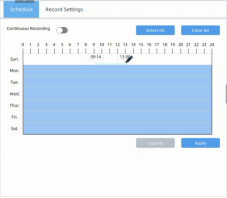
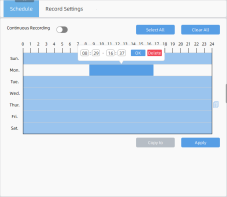

Step4 Enable Continuous Recording  and do not forget to Click Apply to save.
and do not forget to Click Apply to save.
3.2 Continuous Record Settings
Step1 Select Settings→Devices→Camera Record Schedule→Record Settings;
Step2 Click Server List or Group List to show devices from different servers or groups. Click one camera to configure this channel’s record.
Step3 Configure specific settings of the camera after continuous recording is enabled.
Table1 Description of the settings
Parameters |
Function Introduction |
Record Stream |
Set record stream as primary, secondary or both of them |
Record Contain |
Select whether the record includes audio or not |
Pre Record Duration |
Set the duration of pre-recording from 1s to 10s |
Post Record Duration |
Set the duration of post-recording from 10s to 60s |
Archive Minimum Retention Time |
Set minimum time for recording to expire: Auto(delete the oldest recordings based on the disk capacity); Preset times; Custom time from 1 to 365 days |
Archive Maximum Retention Time |
Set maximum time for the recording to expire: Auto(delete the oldest recordings based on the disk capacity); Preset times; Custom time from 1 to 365 days |
ANR |
Set whether to enable ANR which needs a SD card inserted in Milesight camera added via MSSP |
3.3 Copy Record Schedule and Settings
Both Schedule and Record Settings support copy one channel’s to others’. We take Record Settings as an example.
Step1 Click Copy to and then check the cameras you want to copy the configuration to.
Step2 You can also see all cameras from different Servers or Groups by selecting Server List or Group List.
Step3 Click Save and you will find the checked cameras’ configuration is the same as the first one.
4. Event Record
Event Record of VMS Enterprise is based on Event Rules. So you need to set it in Event Rule Settings interface.
Step1 Select Settings→System&Servers→Event Rule Settings and click Add to set a new rule;
Step2 Select the event which you want to trigger the recording. We take Region Entrance in Front-end VCA as an example. Then click <Any Camera> and all cameras will show up in Server List or Group List. Check one or more cameras as the source and click save.
Step3 Click  to bring up the window of schedule. The way to configure it is just the same as it in Continuous Recording. Don’t forget to click Save.
to bring up the window of schedule. The way to configure it is just the same as it in Continuous Recording. Don’t forget to click Save.
Step4 Check Do Recording or Primary Emergency Recording in Action List. Primary Emergency Recording is based on recording schedule, which should be configured first at Camera Recording Schedule. Trigger primary stream recording when event occurs.
Table2 Description of the settings
Parameters |
Function Introduction |
Do Recording |
Primary Emergency Recording |
Target |
Set which camera to record: Source Camera(One-to-one means that event from a particular camera triggers recordings of not all source cameras but only this camera when there are more than one source cameras); Custom selected cameras |
√ |
√ |
Action Interval |
Set time interval between two Actions: Instant; 5s; 10s; Custom time from 1 to 3600s |
√ |
√ |
Pre Record |
Set the duration of pre-recording from 0s to 10s |
√ |
× |
Duration |
Set the duration of whole action: While Trigger Happening; Custom time from 1 to 3600s |
√ |
√ |
Post Record |
Set the duration of post-recording from 0s to 120s |
√ |
× |
Record Stream |
Set record stream as primary or secondary stream |
√ |
× |
Description of Rule |
A brief description as needed for easily finding this rule |
√ |
√ |
Step5 Configure the event record rule as needed and click Save.
Step6 Click Apply to save the rule changes.
Take the following figure as an example, when Panoramic Dome Camera detects Region Entrance, it will trigger recording its video. Don’t forget to click Apply in Event Rule Settings interface.
Note: All front-end triggers should be enabled on Milesight camera side first. You can configure it in Device Events module.
5. Basic Playback

Click Playback on the top. And then the playback interface will show up. Choose and double click a channel from Server List or Group List to replay your recordings. The icon  means this channel has recordings to play.
means this channel has recordings to play.
(1) Toolbar on the top
Move your mouse to the video, and then the toolbar will show on the top.
Click  to turn on Speaker, and you can adjust the volume of the speaker from 1~100. This item is available only for cameras which support built-in mic or Audio I/O.
to turn on Speaker, and you can adjust the volume of the speaker from 1~100. This item is available only for cameras which support built-in mic or Audio I/O.
Click  to enable digital zoom. A thumbnail of the enlarged position is displayed in the lower right corner. Mouse dragging and wheel scrolling to move and zoom in/out.
to enable digital zoom. A thumbnail of the enlarged position is displayed in the lower right corner. Mouse dragging and wheel scrolling to move and zoom in/out.
Click  to take a snapshot. The blue text will lead you to the snapshot storage path.
to take a snapshot. The blue text will lead you to the snapshot storage path.
Click  to open the Fisheye toolbox. Here are a list for each icon of Fisheye toolbox.
to open the Fisheye toolbox. Here are a list for each icon of Fisheye toolbox.
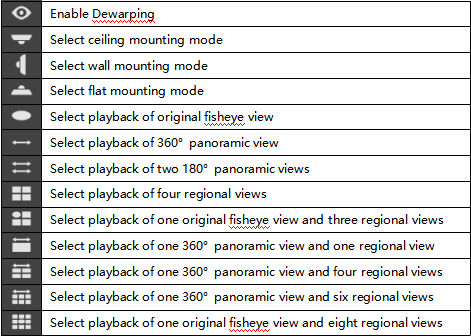
Click  to close this channel’s playback.
to close this channel’s playback.
(2) Right-Click Menu
Right click the video and the menu will show up.
The meanings of the items on the right-click menu can be referred to the table below:
Item |
Description |
Stream Type |
Auto, Primary and Secondary supported. Auto means the playback video will automatically switch stream according to computer performance. |
Display Info |
Choose to display stream information at Left or Right, or customize the position of info. You can also hide the stream information. |
Split Playback |
Divide the video files into several channels during specified time period. Users can watch playback videos of different time periods simultaneously. |
Add Tag for |
Add tag for the selected cameras or all cameras in the playback panel. |
Remove |
Choose Selected Views or All Views in Layout to remove the camera playback. |
Save As Layout |
Click it to save the current layout to Layouts list. |
Cell Spacing |
Set the cell spacing size among the live view windows in the layout. There are four options available, including None, Small, Normal and Large. |
Aspect Ratio |
Choose 1:1, 4:3, 16:9, 3:4 and 9:16 to show the window aspect ratio. |
Pause/Resume all |
Pause/Resume all playback in the current layout. |
Turn on/Mute All Speakers |
Enable or disable the speakers of all cameras in the current layout. |
Stream Type for All |
Set stream type for all cameras in the current layout. |
Display Info for All |
Set to display stream information of all channels in the current layout. |
Full Screen |
You can choose Layout to display all cameras in the layout to full screen. Click again the Exit Full Screen to restore the normal window. |
Right click on a position in the layout where there is no video and the menu will change into:
There are two more items:
Add Tag for All |
Add tag for all cameras in the playback panel. |
Remove All Views |
Remove all cameras’ playback from this layout. |
(3) Playback Toolbar
Select a certain channel in the current layout and click  to show the calendar. The blue date and time both indicate availability of recordings. Click the date and time you want to locate to.
to show the calendar. The blue date and time both indicate availability of recordings. Click the date and time you want to locate to.
Click to lock recording file, and you can set locked time duration and notes.
to lock recording file, and you can set locked time duration and notes.
Click  to add tags for selected channels, and you can set tag name, note and time duration.
to add tags for selected channels, and you can set tag name, note and time duration.
Click  to show Archive Management which can be used to check and retrieve tag and lock files.
to show Archive Management which can be used to check and retrieve tag and lock files.

Click  to switch to Asynchronous Playing or Synchronous Playing.
to switch to Asynchronous Playing or Synchronous Playing.
Asynchronous Playing: The timeline only represents the recording of selected channel.
Synchronous Playing: Playback all channels in the current layout synchronously. The thick timeline bar represents recordings of currently selected camera, while the thin bar represents recordings of all channels in the current layout.
Click  /
/ to play previous or next event video.
to play previous or next event video.
Click /
/ to play previous or next frame of the recording.
to play previous or next frame of the recording.
Click /
/ to adjust the playback speed to 1/32, 1/16, 1/8, 1/4, 1/2, 1X, 2X, 4X, 8X, 16X or 32X.
to adjust the playback speed to 1/32, 1/16, 1/8, 1/4, 1/2, 1X, 2X, 4X, 8X, 16X or 32X.
Click /
/ /
/ to rewind, play or pause the video.
to rewind, play or pause the video.
Click to move the current playback time to the center of timeline bar. The short white vertical line which represents the position of the current playback moment will move to the centre of the time bar.
to move the current playback time to the center of timeline bar. The short white vertical line which represents the position of the current playback moment will move to the centre of the time bar.
Drag to zoom in/out timeline bar. Or you can just scroll the mouse wheel on timeline bar to do so.
to zoom in/out timeline bar. Or you can just scroll the mouse wheel on timeline bar to do so.
(4) Right-Click Timeline Bar
Right-Click the timeline bar and hold down to drag to move the time bar sideways.
Right-Click the timeline bar, the menu will show up as follows. If there has been a part of video selected and it contains locked video and tags, right-click menu will have more items.
The meanings of the items on the right-click menu can be referred to the table below:
Item |
Description |
Start Selection/End Selection |
Select start/end time of period on the timeline. |
Clear Selection |
Clear selection on the timeline. |
Zoom to Selection |
Extend the selected period to whole timeline. |
Add Tag |
Add tag for the selected period. |
Lock File |
Lock the selected period. |
Split Playback |
More Details in 6.2 Split Playback |
Export Video |
Export the selected period. |
Unlock File |
Unlock the locked video file. |
Edit Tag |
Edit tag which you set. |
Export Tag |
Export tag which you set. |
Play Tag Video |
Play videos with tag you set. |
Delete Tag |
Delete tag which you set. |
Show Thumbnails |
Show thumbnail of the corresponding time. Users can also resize the thumbnail timeline as needed. |
Show Tags |
After setting the tags, you can choose the option to show the tag on the timeline
|
Show Locks |
After setting the lock files, you can choose the option to show the lock file on the timeline |
(5) Tags for Playback
Click the Hide/Show bottom to pop-up right side menu and click the tag icon to show Tags for Playback.
Select which channels to search tags from.
Select which types of tags to search.
Select the time duration for searching tags
Search keyword of tags’ names and notes. Refresh the tag list and chose how to sort the tag list (Tag Start Time, Tag Name, Camera Name and Create Time).
Double click the tag you want, and the video of the corresponding channel then jumps to the time of the tag and flashes the window.

6. Event and Split Playback
(1) Event Playback
If the channel is configured with rule-triggered recording, the timeline bar of Playback will have different colors representing different events.
Click Show Event Mask to check event type to be shown on the timeline, the timeline will show different colors according to selected event type as below:
Click the  button to enter Event Mask Colors Setting interface, it supports customizing different colors for different events according to the user’s requirement.
button to enter Event Mask Colors Setting interface, it supports customizing different colors for different events according to the user’s requirement.
Click Event Only to exclude continuous recording.
(2) Split Playback
Split Playback allows you to divide a period time of recording into several parts when watching playback, so that users can watch videos of different time simultaneously.
Split Playback setting steps are as below:
Step1: Right click the playback window of a channel and click Split Playback, or right-click the selected time period on the timeline and choose Split Playback, and a window will pop up.

Time Period setting
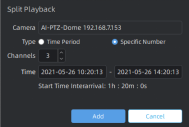
Specific Number setting
Step2: Check a type to split the video file. If you choose the Time Period, and set Time Interval and Start/End Time, then the channels will be split automatically by VMS system as above. If you choose the Specific Number, and set channel number and Start/End Time, then Time Interval will be calculated and split automatically by VMS system as above.
Step3: After setting, click , and the selected video will be split to new channels to replay asynchronously on the playback layout as shown below:
, and the selected video will be split to new channels to replay asynchronously on the playback layout as shown below:
How to Use VMS Enterprise Video Wall
“Milesight VMS Enterprise” supports Video Wall function, which is a necessary advanced function for professional VMS. The Video Wall function supports custom screen combinations and split. It can divide a single monitor into multiple screens, which can be divided into up to 4 screens, or combine multiple monitors into one screen. It controls the maximum number of screens that can be run with a license. If the number of screens connected to the client computer is large enough, more screens can be generated. Moreover, the screens generated by the Video Wall are independent of each other. In particular, the Video Wall function can push the computer desktop to the wall.
Here are some professional terms related to Video Wall, so that you can better understand the function.
-
Monitor
Refers to the monitors actually connected to the client computer.
-
Screen
Refers to the areas created based on monitor for displaying video.
-
Video Wall
It’s made up of screens.
-
Matrix
It is composed of the contents and layout displayed on the Video Wall screen.
Chapter II Operations
2.1 How to Set Video Wall?
Note:
① Make sure that there is a license for Video Wall in the system, and the license quantity is sufficient.
② Make sure the Video Walll Server is installed and running on the Client you want to connect to.
Step1: First, click the button [Creat Video Wall] to create the Video Wall in the Settings -> System & Servers -> Video Wall Settings interface.

Then you can click  to rename the Video Wall.
to rename the Video Wall.
Step2: Click the button  to pop up the Add Screens window, and all Clients in the LAN will be displayed in the list. You can refresh the list and search the Client.
to pop up the Add Screens window, and all Clients in the LAN will be displayed in the list. You can refresh the list and search the Client.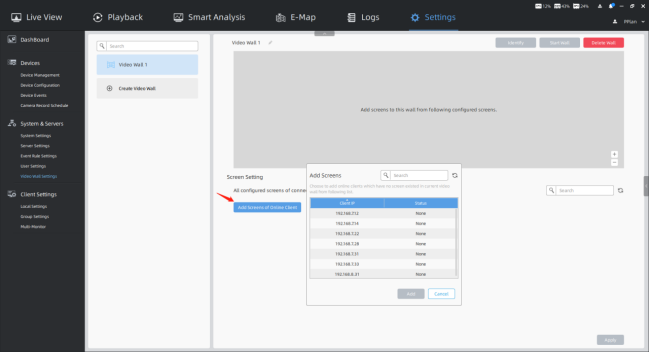
Step3: Then select the Client whose screen does not exist in the current Video Wall in the LAN from the list, and click the button . You can also add multiple Online Clients as needed. Then these added Clients will be displayed in the Screen Setting list. And all monitors actually connected to these Clients will be displayed on the Clients.
. You can also add multiple Online Clients as needed. Then these added Clients will be displayed in the Screen Setting list. And all monitors actually connected to these Clients will be displayed on the Clients.
You can refresh the Screen Setting list and search for the added Clients. If you want to delete the Client, you can click the button .
.
Step4: Click on a blank area of a monitor on the Client to create a new screen, then you can click and drag the screen to adjust the position. And the screen selected box has 8 small squares that you can drag to adjust the screen size. Each monitor can be divided into up to 4 screens.
In addition, you can click the screen and then click the screen name to rename it, and delete the screen by clicking the icon  in the upper right corner of the screen.
in the upper right corner of the screen.
Step5: Click the screen you want, and then click the button  to add the screen to the Video Wall. You can add multiple screens as needed.
to add the screen to the Video Wall. You can add multiple screens as needed.
You can click and drag any screen on the Video Wall to adjust the position, and drag the small squares of the selected box to adjust the screen size. Click the icon  to delete the screen on the Wall. And you can also adjust the layout of the Video Wall by clicking the icons
to delete the screen on the Wall. And you can also adjust the layout of the Video Wall by clicking the icons  or sliding the mouse wheel.
or sliding the mouse wheel.
Step6: Click the button  to apply the settings.
to apply the settings.
Step7: Then click the button  to run the Video Wall. And then you can use Video Wall function in the Live View interface.
to run the Video Wall. And then you can use Video Wall function in the Live View interface.
When the Video Wall is running, you can still click and drag any screen on the Video Wall to adjust the screen position and size, which is convenient to match the actual physical position composition of each screen.
In addition, click the button  to identify the corresponding screens. And you can click the button
to identify the corresponding screens. And you can click the button to stop running the Video Wall. Or click the button
to stop running the Video Wall. Or click the button  to delete the Video Wall.
to delete the Video Wall.
2.2 How to Use Video Wall?
The Video Wall list created in the Video Wall Settings is displayed in the left Resource panel of the Live View. And you can use all screens in the local area network.
Note:
The icon  indicates that the screen is not available, you need to check if the Video Wall Server is running normally.
indicates that the screen is not available, you need to check if the Video Wall Server is running normally.
2.2.1 How to Run Video Wall?
Step1: Right-click the Video Wall and a menu window will pop up as below:
[Control Video Wall]: Pop up the Video Wall control window to use the Video Wall.
[Start Wall]: Run the Video Wall.
[Rename]: Rename the Video Wall.
[Video Wall Settings]: Jump to the Video Wall Settings page.
Step2: Select [Control Video Wall] option, and then the following window pops up:
Step3: Click the button  to run the Video Wall. Then you can drag and drop the cameras, layouts and tour plans to the screens.
to run the Video Wall. Then you can drag and drop the cameras, layouts and tour plans to the screens.
After running the Video Wall, you can also do the following:
-
l Click the button
 to identify all running screens in the Video Wall.
to identify all running screens in the Video Wall. -
l Click the button
 to clear the content on all screens in the Video Wall.
to clear the content on all screens in the Video Wall. -
l Click the button
 to stop running the Video Wall.
to stop running the Video Wall.
In addition, you can double-click the screen to enter the specific screen. And you can also right-click the screen to do something. For more details, please refer to How to Run Screen?.
Step4: When the Video Wall is running, you can right-click the Video Wall and a menu window will pop up as below:
[Control Video Wall]: Pop up the Video Wall control window to use the Video Wall.
[Stop Wall]: Stop running the Video Wall.
[Clear Wall]: Clear the content on all screens in the Video Wall.
[Rename]: Rename the Video Wall.
[Save Matrix]: Save the content currently playing on each screen of the Video Wall. For more details, please refer to How to Save and Load Matrix?.
[Identify Screens]: Identify all running screens in the Video Wall.
[Video Wall Settings]: Jump to the Video Wall Settings page.
2.2.2 How to Run Screen?
Step1: Right-click the screen and a menu window will pop up as below:
[Control Screen]: Pop up the screen control window to use the screen.
[Start Screen]: Run the screen.
[Rename]: Rename the screen.
Step2: Select [Control Screen] option, and then the following window pops up:
Step3: Click the button  to run the screen. Then you can drag and drop the camera, layout and tour plan to the screen.
to run the screen. Then you can drag and drop the camera, layout and tour plan to the screen.
After running the screen, you can also do the following:
-
l Click the button
 to refresh the screen.
to refresh the screen. -
l Click the button
 to identify the corresponding screen.
to identify the corresponding screen. -
l Click the button
 to clear the content on the screen.
to clear the content on the screen. -
l Click the button
 to stop running the screen.
to stop running the screen.
Step4: When the screen is running, you can right-click the screen and a menu window will pop up as below:
[Control Screen]: Pop up the screen control window to use the screen.
[Stop Screen]: Stop running the screen.
[Rename]: Rename the screen.
[Clear Screen]: Clear the content on the screen.
[Identify]: Identify the corresponding screen.
[Push My Desktop]: Push the desktop to the screen for display. If there are multiple desktops, select any one to push as needed.
2.2.3 How to Save and Load Matrix?
Step1: Right-click the Video Wall and select [Save Matrix] option to save the content currently playing on each screen of the Video Wall. The Save Matrix window will pop up, you can edit the matrix name, and then click the button  .
.
Note:
Make sure the Video Wall is running.
Step2: Then right-click the matrix and a menu window will pop up as below:
[Load to Video Wall]: Each screen will play the content according to the matrix.
[Save]: Save the content currently playing on each screen of the Video Wall to the matrix.
[Rename]: Rename the matrix.
[Set As Default]: Set the matrix as default. Every time you run the Video Wall, each screen will play the content according to the matrix. There is at most one default matrix.
[Delete]: Delete the matrix.
Step3: Select [Load to Video Wall] option, and then the following window pops up:
Click the button  , and then each screen will play the content according to the matrix.
, and then each screen will play the content according to the matrix.
VMS Enterprise Architecture
Chapter I Introduction
The Milesight VMS Enterprise is featured with Client/Server architecture. The user accesses a system by logging into any server of the system on the client side.

l Server
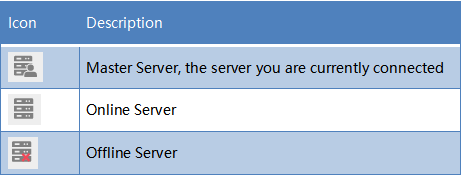
Server refers to Milesight VMS Enterprise Server which are installed on the computer. The initial state of a server is an undefined server. Available on Windows.
A server is responsible for:
-
Communicate with clients and other servers (Only master server)
-
Camera management
-
Get video stream from cameras and forward to client
-
Record video from cameras to local or NAS storage
-
Get event signals and trigger different actions
-
Smart analysis – Store license plate recognition results and black/white list comparison
Recommend: The maximum number of cameras per server is 128.
l System
Icon
A system is made up of one or more servers. Any undefined server needs to be created as a new system or added to an existing system for use.
Multiple servers can form a system which can manage lots of network cameras in different locations. Every server in the same system shares all information about all cameras, users and settings except for recording files.
Recommend:
The maximum number of cameras per system is 2000. The maximum number of servers per system is 25.
l Client
Client refers to Milesight VMS Enterprise Client which are installed on the computer. Available on Windows.
A client is responsible for:
-
Connect to any server, but only to one at a time
-
Camera management, configuration and control
-
View Live videos, up to 4 monitors and 64 channels per monitor
-
Video playback, up to 64 channels synchronously or asynchronously
-
Smart analysis – Black/white list management, ANPR settings and smart search
-
View event notification
-
System and server settings
-
View event logs and audit trail
Note: D3D is required
l User

Every system has a list of user accounts that can have different rights. Only authorized user can access the system. Users are authorized by roles, and there are different types of roles.
Owner: There is only one ‘Owner’ user in the system. It is created when the system is created. It has the highest privileges
Administrator: It owns full access to function and operation permissions, resource access including Camera and Layout
Operator: It can see all cameras and own part access to function and operation permissions in the system
Viewer: It can see all cameras and have view permissions for only partial functions in the system
Custom role: Customize access permission to function, operation and resource including Camera and Layout
Recommend: The maximum number of users per system is 100.
l Login Interface
Interface Description:
Chapter II Operations
2.1 How to add an undefined server into a system
1. Add an undefined server into a new system
Step 1: Click an undefined server in the login interface. (Undefined servers are shown at the bottom of the list.)
Step 2:Select “New System”to create current server as a new system. (“New System” is shown at the bottom of the selections.)
Step 3:Set the system name, server name and an “Owner” user of the new system, then click “Save”.
You can check “Connect After Save”, then it will log in the system automatically after clicking “Save”.
2. Add an undefined server into an existing system
Step 1:Click an undefined server in the login interface.
Step 2: Select an existing system.
Step 3: Configure server name and enter the owner’s authentication credentials of the system, then click “Save”.
You can check “Connect After Save”, then it will login the system automatically after clicking “Save”.
Note: If the password is entered incorrectly more than 6, the system will be locked for 30 minutes.
2.2 How to detach a server from a system
Step 1:Click “Settings” in the top menu bar. And Click “System & Servers” -> “Server Settings” in the left menu bar. Select the sever in the server list, click “Detach Server”.

Step 2: Click “I Agree”.
If there are multiple servers in the system, you can choose to remove or keep the cameras added to this server.
l Remove cameras of this server from system: after detaching the server from the system, the cameras added to this server will be deleted at the same time.
l Keep cameras of this server in system: after detaching the server from the system, the cameras added to this server will be allocated to other servers of the same system automatically for load balancing.
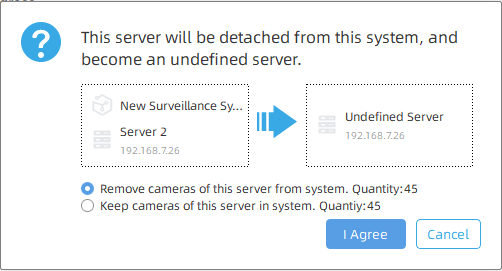
After detaching the server from the system, then it becomes an undefined server.
Note:
1.Only the Owner user has permission to perform the “Detach Server” operation.
2.When a server is offline, if you click “Delete Server”, the server isn’t really detached from the system. It just doesn’t be shown in the server list. Once the server restores online, it still can be displayed in the server list and start working.
If a server has been added into a system, it needs to be detached from the system as an undefined server, then add the undefined server into other system.
